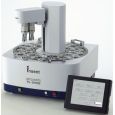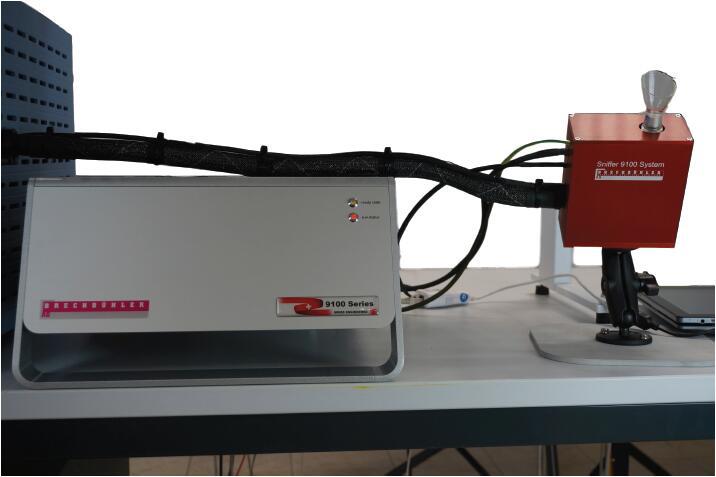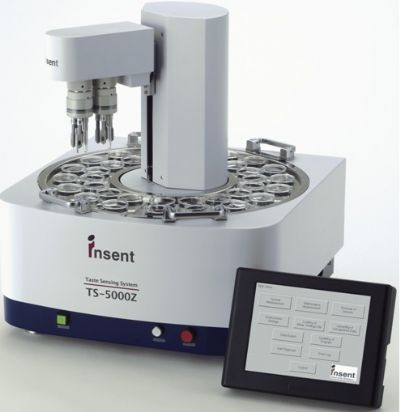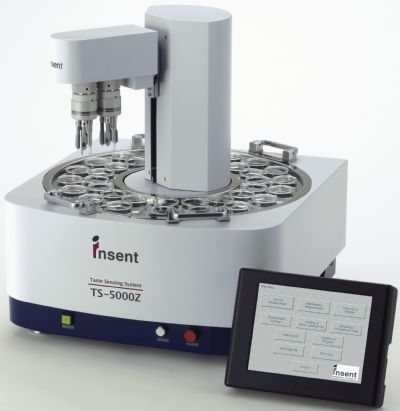
方案详情
文
本研究的目的是:(1)确定鲜奶前乳和鲜奶后乳的感官特性;:(2)建立鲜奶感官特性与鲜奶成分之间的关系;(3)评估母体饮食的苦味与鲜奶之间的关系。
方案详情

J. Dairy Sci. 102:1116-1130https://doi.org/10.3168/jds.2018-15339 1117SENSORYCHARACTERISTICS OF HUMAN MILK @American Dairy Science Association, 2019. Sensory characteristics of human milk: Association between mothers'diet and milk for bitter taste Dimitra Mastorakou,12Angelica Ruark,2 Hugo Weenen,* Bernd Stahl, and Markus Stieger Danone Nutricia Research, Uppsalalaan 12, 3584 CT Utrecht, the Netherlands Wageningen University, Division of Human Nutrition, P.O. Box 17, 6700 AA Wageningen, the Netherlands It is unknown how consumption of bitter foods andbeverages in the maternal diet influences sensory prop-erties of fresh human milk. The aims of this study were(1) to determine the sensory characteristics of fresh hu-man fore and hind milk, (2) to establish relationshipsbetween sensory properties and composition of freshhuman milk, and (3) to assess the relationship betweenbitterness of the maternal diet and human milk. Twen-ty-two lactating mothers generated sensory terms to de-scribe perception of their milk and received training onsensory attribute intensity rating. Mothers kept a 24-hfood diary followed by a sensory self-assessment of theirfore and hind milks. The odor of human fresh milk wasdescribed as neutral, creamy, and sweet, taste as sweetand bitter, and mouthfeel as thin, watery, smooth, andfatty. Sweetness was equivalent to 1.53 g of sucrose/100mL and was not significantly different between fore andhind milk. Fore milk was significantly less creamy, lessfatty, thinner, more watery, and lower in vanilla flavorintensity than hind milk. Carbohydrate content of hu-man milk was positively correlated with sweetness andglutamic acid content with umami. The bitterness ofthe diet consumed 24 h before lactation was moderatelypositively correlated with bitterness of fore milk, butnot hind milk. We conclude that the consumption ofbitter foods may influence the bitterness of human foremilk, which may be another way for breastfed childrento learn to accept bitter vegetables and, hence, develophealthier food preferences. Key words:breastfeeding, humanmilk,sensoryperception, bitterness, maternal diet Consuming a varied and healthy diet over a lifetimecan provide adequate amounts of nutrients essential for ( Received J uly 6 , 2 018. ) ( Accepted O ctober 17, 2018. ) ( * C o rresponding author: hugo.weenen @ danone.com ) growth and development and prevent malnutrition andnoncommunicable chronic diseases (WHO/FAO, 2002).For infants, human milk is the ideal form of nutritionfor growth and development in their first years of life,as it provides a variety of bioactive components thatare beneficial for infant health (Ballard and Morrow,2013). In later life, a varied and balanced diet in agree-ment with nutritional recommendations is often notfully achieved by children. Especially regarding fruitand vegetable intake, US and European children arefar from reaching the recommended dietary guidelines(Yngve et al., 2005; van Rossum et al., 2009). Thelimited acceptance of vegetables has been suggested totrace back to our evolution. Humans reject bitter foodsto avoid toxic compounds commonly found in plants(Ames et al., 1990;Drewnowski, 1997; Drewnowski andGomez-Carneros,2000).rejection for bitter foods has been important for humansurvival. Rejection of bitterness is observed in manyspecies, including goats, sheep, and cattle (Goatcherand Church, 1970). Especially in children, taste canoften drive food preference and choice (Drewnowski,1989, 2000). Early-life flavor experiences and eatingbehavior can influence food preference and choice inchild- and adulthood (Lytle et al., 2000; Lien et al.,2001; Skinner et al.,2002;Nicklaus et al., 2005; Cookeand Fildes, 2011; Nehring et al., 2015); therefore, thechallenge of increasing children’s vegetable consump-tion should start early in life. Infants experience flavors of foods for the first timeby the transmission of dietary volatiles from their moth-ers’ diet to the amniotic fluid and breast milk (Men-nella, 2007). During the first 4 mo of life, breastfeedingconfers a greater acceptance of these foods, particularlywhen they are part of the mother’s diet (Sullivan andBirch 1994; Mennella et al., 2001). The more varied themother’s diet is during lactation, the more varied theflavor of her milk (Mennella, 2007); this could explainwhy children who were breastfed are less picky andmore willing to try new foods as they grow comparedwith children who were fed formula (Galloway et al.,2003). A recent study showed that drinking carrot and broccoli juice during breastfeeding increased theinfant’s acceptance of carrot-flavored cereal severalmonths later, but did not affect acceptance of broccoli-flavored cereal (Mennella et al., 2017). Consistent withthis is that duration of breastfeeding was shown to bea predictor of vegetable intake (de Wild et al., 2018). Human milk (Buettner, 2007), aswell as bovinemilk (Toso et al., 2002;MacGibbon and Taylor, 2006),contain odorants from various chemical categories, in-cluding fatty acids, aldehydes, terpenoids, and ketones.Transference of flavor compounds through maternalmilk has been shown as early as the 18th century(Bradley, 1757; Babcock,1938; Shipe et al., 1978).Volatile components, such as 1,8-cineole (Kirsch et al.,2013), D-carvone, trans-anethole, L-menthol (Hausneretal., 2008), vanillin. (Mennella, and Beauchamp,1996a), garlic (Mennella and Beauchamp, 1991a), car-rot flavor volatiles (Mennella,and Beauchamp, 1999),ethanol (Mennella, and Beauchamp, 1991b), volatilesfrom cigarettes (Mennella and Beauchamp, 1998), andcaffeine, theobromine, paraxanthine, theophylline, andnicotine (Aresta et al., 2005), have been shown to betransmitted to human milk. As far as we know, the sensory characteristics of freshcow milk as well as cow fore and hind milk have notbeen reported. Instead, most studies on the sensorycharacteristics of cow milk (for review see Schiano etal., 2017) have focused on the effect of fat content (Mc-Carthy et al.,2017), various ways of preservation (Leeet al., 2017), off-flavors (Alvarez, 2008), and changesover shelf-lifee (Fromm and Boor, 2004). Attributesthat have been listed as relevant for milk include sweetaroma, cooked, sulphury/eggy, milk fat/lactone, cara-melized, butterscotch, feed/malty/silage, grassy, cowy/barny/phenolic, metallic/serum, fruity, cardboard, car-roty, sweet taste, bitter taste,astringent, and viscous.To the best of our knowledge, and in contrast to numer-ous studies describing sensory properties of processedbovine milk (for review see Schiano et al., 2017), onlyone study has been reported describing the in-mouthsensory properties of human milk based on a trainedsensory panel (McDaniel et al., 1989). In that study,fore and hind milks expressed on 3 consecutive daysby 24 mothers were compared for a limited numberof sensory attributes (sweetness, viscosity, and mouthcoating) using a trained panel consisting of 6 women. Intheir study, fore milk was defined as approximately thefirst 30 mL expressed from the first breast before theinfant was nursed, whereas hind milk was approximate-ly the final 30 mL expressed from the first breast afterthe infant was removed from the breast. Differences insweetness among milks obtained on different days fromthe same mother were observed in that study. Viscos- ity and mouth coating of milks obtained on differentdays from the same mother did not differ. Hind milkwas more viscous than fore milk, as shown from bothsensory evaluation and rheological measurements. Hindmilk was more mouth-coating and had a lower lactoseconcentration than fore milk. The difference in lactoseconcentration between fore and hind milk was 0.2%(wt/wt) and was considered too small to cause a differ-ence in sweetness. Fat content of milks ranged from 0.57to 4.12 g/100 mL. Hind milk had a significantly higherfat content than fore milk. Protein content ranged from0.63 to 2.15 g/100 mL and hind milk contained sig-nificantly more protein than fore milk. In comparison,Mitoulas et al. (2002) found significant differences infat content between fore and hiiatnd milk throughout thefirst year of lactation and no significant differences inprotein and lactose content. Two other studies reportedsensory profiles of fresh and stored frozen human milk(Spitzer et al., 2010) and after storage at 4℃ (Spitzeret al., 2013). A panel evaluated orthonasal intensitiesof odor attributes and found these to be very low forfresh human milk (Spitzer et al., 2010). Five untrainedmothers evaluated the in mouth intensities of11 aromaattributes using their own milk. Aroma attributes witha mean intensity rating of 2 (3-point scale) includedsweet, fatty, soya-like, whereas those with a mean in-tensity rating of 1 included buttery and cooked milk-like (Spitzer et al., 2010). Another study compared human milks of motherswith mastitis and noninflamed breasts. Taste intensitiesmeasured with an instrumental taste sensor (SA402BE-tongue sensor, Higuchi, Tokyo, Japan) significantlycorrelated with composition of milks, specifically in-strumentally determined sourness correlated positivelywith lactose content, instrumentally determined salti-ness with lactose (positive) and calcium content (posi-tive), and instrumentally determined bitterness withcalcium content (negative), urea content (positive) andpH (negative; Yoshida et al., 2014) To summarize, sensory characteristics of humanbreastmilk can be influenced by maternal diet andcan contribute to shaping an infant’s and child’s ac-ceptance of foods. In contrast to numerous studies onthe effect of feed on the composition of bovine milk(e.g., Sutton, 1989; Palmquist et al., 1993), detailedunderstanding is lacking about the influence of thematernal diet on taste and sensory properties of hu-man milk and how the diet can be altered to influencechildren’s food preferences. Sensory properties of freshhuman milk have been described by only 2 studies: onestudy used a trained panel and assessed only 3 sensorydescriptors, whereas another study was based on theself-assessment of human milk by untrained mothers and did not distinguish between fore and hind milk(Spitzer et al., 2010). Hence, knowledge about sensoryproperties of fresh human fore and hind milk is verylimited. A particularly interesting question is how thebitterness of the maternal diet influences bitternessperception of human milk, as this might be relevant fordevelopment of acceptance of vegetables by children.Previous studies using hydrolyzed formulas (Mennellaand Beauchamp,1996b) have shown that bitter taste isrelatively well accepted in the first few months of life.Repeated exposure to bitter-tasting hydrolyzed formulaincreases acceptance of formula. This raises the ques-tion how the maternal diet affects bitterness of humanmilk and how this affects acceptance of bitter foods,such as vegetables, later in life. Research by Aresta etal. (2005) has shown that bitter-tasting alkaloids canbe transferred from the maternal diet to milk; thus, weexpected that the maternal diet may affect bitterness ofhuman milk. Nevertheless, this has not been reported1...1The aims of our study were (1) to determine the sen-sory characteristics of human fore and hind milk, (2) toestablish relationships between sensory properties andcomposition of human milk, and (3) to assess the re-lationship between bitterness of the maternal diet andbitterness of human milk. MATERIALS AND METHODS Twenty-two nonsmoking, breastfeeding, apparentlyhealthy volunteer mothers aged 28 to 43 yr participatedin the study. The minimum number of subjects hadbeen set at 20, as in a previous pilot study a significantcorrelation between bitterness of the maternal diet andresulting milk was found in a sample of 10 mothers;therefore, a minimum of 20 mothers was assumed tobe sufficient to detect or confirm such a correlation.Mothers were recruited via posters at various locationsin the Utrecht Science Park (Utrecht, the Netherlands)or with the assistance of OP&P (Utrecht, the Neth-erlands). Selection criteria were that mothersbreastfeeding for at least 1 mo until 12 mo and pro-duced adequate milk. Before the start of the study, apilot study was performed with 2 mothers to ensure thestudy design was appropriate. The results of the pilotstudy are not included in the data analysis. All motherswere informed about the procedures before the study..1and signed an informed consent form. The study wasconducted according to the guidelines laid down in theDeclaration of Helsinki. The project proposal, includingquestionnaires, advertisement, and consent form weresubmitted to an accredited Medical Research Ethics Committee (Independent Review Board, Nijmegen, theNetherlands), which confirmed that the study did notrequire review by an ethical committee according toDutch law (reference number IRBN2016003 HdJ 1).The demographics of the 22 mothers who participatedin both sessions were collected through the use of aquestionnaire that the mothers filled in before session2. Three mothers who initially participated in the firstsession were unable to participate in the second sessiondue to low milk supply. Study Design Participants were requested to arrive at the researchcenter at the same time in the afternoon on 2 d,toparticipate in sessions of 60 to 90 min. During the firstsession, mothers became familiarized with the 5 basictaste modalities (sweet, salty, bitter, sour, and umami)and creaminess using reference samples with varyinglevels of intensity. Mothers generated sensory terms todescribe odor, flavor, and mouthfeel of their own milk.In the second session, mothers evaluated their fore andhind milk on various sensory characteristics. Analyticalmeasurements were conducted for fore and hind milkto quantify fat, carbohydrate, total protein, and freeAA content. Between the 2 sessions, a 24-h food diarywas kept by the mothers to assess the bitterness of thematernal diet. Procedure Preparation of Reference Solutions. Referencesolutions were prepared for the evaluation of basic tasteintensities and creaminess.The concentrations used forthe reference solutions are listed in Table 1. Sucrose Table 1. Concentrations of reference solutions used during sensory evaluations of human fore and hind milkby the 22 mothers Concentration Recognition threshold Attribute Substance (% wt/wt) (% wt/wt) Sweet Sucrose First: 1.06 0.121,0.576 Second: 2.12" Third: 4.24 Salty Sodium chloride First: 0.032 Second: 0.080 Third: 0.200 0.046,0.119 Sour Citric acid First: 0.009 Second: 0.022 0.012,0.028 Bitter Caffeine Third: 0.056 First: 0.009 Second: 0.022 Third: 0.054 0.011,0.020 Umami Monosodium glutamate First: 0.024 Second: 0.060 0.013,0.029 Creamy Milk fat Third: 0.151 First: 1.6 Second:4.0 NA3 Third: 10.0 Estimated recognition thresholds for all taste modalities are shown. Recognition thresholds were calculatedbased on (first value) Hoehl et al. (2010) and (second value) ISO (2011)."Solutions used as reference during session 2.NA = data not available in the literature. (Suiker Unie, Oud Gastel, the Netherlands), sodiumAlchloride (Akzo Nobel Industrial Chemicals B.V., Arn-hem, the Netherlands), monosodium glutamate (Cori-mex Unilever, Rotterdam, the Netherlands), caffeine(Sigma-Aldrich, St. Louis, MO), and citric acid (MerckKC Darmstadt, Germany) wewreree u suseedto preparesweet, salty, umami, bitter, and sour solutions, respec-tively. Creamy reference emulsions were prepared bymixing semiskim mmilek (6Friesland Campina, Amersfoort,the Netherlands; 1.5% fat) with w1hipp9ing c ream (Fri-esche Vlag, Friesland Campina; 35.1% fat), both pur-chased from local supermarkets. Evian water (Danone,Paris, France) was always used with the exception ofsour solutions, which were prepared with demineral-ized water. Taste solutions and creamy emulsions weretransferred into 50-mL glass vials and placed in a waterbath at 40°C. Basic tastes have been shown to followFechner’s law, meaning a semi-logarithmic relationshipbetween tastant concentration and perceived intensityholds (Yamaguchi, 1998). As shown in Table1, concen-trations of taste solutions varied by a factor of 2.5× forall taste modalities except sweetness, for which a factorof 2× was used. For bitter, sour, salty, and umami anequi-intensity of 2.5 of the Spectrum scale, as obtainedfrom the study of Martin et al.(2015), was placed at75% of the 100-mm line scales that were provided forthe rating tasks. The concentrations of the referencesfor bitter, sour, salty, and umami were based on Martinet al. (2015) and were equi-intense. If we had followedthe same systematics for sweet, the sucrose concentra- tion for the 75% point on the 100-mm line scales shouldhave been 73.1 mM, which is 2.5 g/100 mL. However,the concentration at the 75% point that we used was4.24 g/100 mL. The references for sweetness were dif-ferent, as they were selected based on the expectedsweetness following McDaniel et al. ((1989). The ex-pected mean sweetness of the human milk samples was2.12 g/100 mL; therefore, the concentration of the 50%mark reference sample for sweet had this concentrationto avoid ceiling effects. When sensory evaluations bythe mothers were performed at home, all solutions werestored in bottle warmers at 40°C. Session 1: Attribute Generation and Trainingf lMothers. The first session consisted of 3 parts:breastmilk expression, generation of sensory attributesto describe human milk by the mothers, and training ofthe mother to assess basic taste and creaminess inten-sity. All 22 mothers were provided with a questionnaireupon entering the research room. The mothers were first requested to express at least50 mL (or as much as they could provide) of milk intheir usual way, using their own pump and filling theirusual bottles. The mothers were given privacy to ex-press their milk. The mothers were asked to indicatewhether they were pumping from a single breast orboth and how many times they pumped or breastfedthat day. The milk was then handed to the researcherwho transferred the milk into a 50-mL glass vial andplaced it in the water bath with the standard solutionsat 40°C. Approximately 10-mL of their own milk was pouredinto a plastic cup for the mother to evaluate. Motherswere first asked to smell the milk and write down asmany sensory attributes as possible to describe the odorperception. Mothers were then asked to do the same forflavor and mouthfeel perception of her milk. For bothelicitation tasks, mothers were instructed to generateobjective terms and avoid subjective terms or opinions.After 5 min, mothers had usually completed the freeterm-elicitation task. Mothers were then presented witha list of attributes from studies on infant formula sen-sory characteristics (van Ruth et al.,2006) and previ-ous research conducted at Nutricia (M. Slagter, DanoneNutricia Research, Utrecht, the Netherlands, personalcommunication). The list of provided attributes can befound in Table 2. From this list, mothers could selectadditional terms that described their own milk. Thepurpose of this task was to facilitate term elicitationfor mothers that had not tasted their milk before. Nodefinitions were provided for sensory attributes. After the attribute-elicitation task, mothers under-went a training session to familiarize themselves withthe 5 basic taste modalities (sweet, sour, salty, bitter,and umami) and creaminess. During the training, allreferences solutions (Table 1) were provided togetherwith 100-mm line scales anchored at the end of thescale with "like water” (“like milk” for creamy) and"strong."Mothers tasted 3 reference solutions differingin concentration for each taste modality and creaminess(Table 1). Mothers were instructed to first rank the 3reference solutions in order of increasing intensity andthen evaluate perceived taste intensity on 100-mm linescales. Mothers used the relative-to-reference method toperform the line scale intensity rating,rating 2 intensi-ties in comparison to a third (Stoer and Lawless, 1993).When mothers did not rank the reference solutions inthe right order, the correct order was shown and moth-ers retasted the solutions to ensure they understood thecorrect ranking order. Between Session 1 and Session 2: 24-h FoodDiary and Bitterness of Maternal Diet. Duringthe 24-h period between the first and second session,mothers filled in a food diary. For this, mothers wereprovided with a kitchen scale (Soehnle, Nassau, Ger-many) and a piece of 85% cacao chocolate (Lindt Ex-cellence Series, Lindt & Spriingli, Zirich,Switzerland)at the end of session 1. Mothers tasted the chocolate48 h before the second session and provided a score forbitterness intensity of the chocolate on a scale from 0 to10 (0= not bitter at all, 10= most bitter) in an openbox on the food diary. Mothers recorded their diet forthe 24-h period between session 1 and 2 by capturingthe time of consumption, description of food or drink Table 2. List of descriptive sensory attributes provided to mothersduring the attribute elicitation task for human milk Smell Flavor Mouthfeel Burned Sweet Thick Creamy Bitter Smooth Metallic/iron Salty Creamy Wet soil Sour Coating Cheesy Umami Dry Vegetable-like Vanilla Slimy Cooked 1Caramel Rough Burned milk Powdery Vegetable oil Fatty Metallic Thin Fishy Watery Attributes were derived from the study of M. Slagter (Danone NutriciaResearch, Utrecht, the Netherlands, personal communication) and lit-erature (van Ruth et al., 2006). consumed,brand name, amount in grams, milliliters, orcommon household measurements (slice, spoon, and soon), and indicated the bitterness score for each producton the 0 to 10 scale relative to the score given for the85% cacao chocolate (Deterre et al., 2012). Foods wereassessed as eaten (e.g., a sandwich was evaluated as awhole, not as the individual components). For thoseitems that were not weighed with a kitchen scale, ap-proximations for weight were made based on a database(CalorieLab, 2016). The photographs that motherstook of their consumed foods were used to check ?4the24-h food diaries for completeness. Session 2: Assessment Session. The second ses-sion consisted of 4 parts: expression of fore and hindmilk, review of 24-h food diary, sensory evaluation offore and hind milk by the mothers on basic taste andcreaminess intensity relative to reference taste andcreaminess solutions, and intensity evaluation of ownfore and hind milks on odor, flavor, and mouthfeel at-tributes. Mothers were first instructed to express at least 30mL of fore milk and 30 mL of hind milk in their usualway, using a pump and filling up their usual bottles.For those unfamiliar with the definition of fore andhind milk, mothers were instructed to collect the first30 mL of their milk and consider this fore milk. Theremaining milk that was expressed was considered hindmilk. Mothers were asked to use 1 breast, and theyinformed the researcher which breast was used. Themothers were given privacy to express their milk. The2 milk samples were then handed to the researcher whotransferred the milks into glass vials and placed themin a water bath at 40℃. For chemical analysis,6 mL offore and 6 mL of hind milk were placed in the refrigera-tor (4℃) to be analyzed immediately after the end ofthe session for fat, protein, and carbohydrate content; 0.5 mL of each milk was placed in a -20℃ freezer tobe analyzed for free AA content. Following the milk expression, mothers reviewed their24-h food diaries with the researcher for clarification.Mothers then assessed taste and creaminess intensity oftheir fore and hind milks relative to reference taste andcreaminess solutions (references used in session 2 areindicated with asterisks in Table 1) using unstructured100-mm line scales anchored at the ends with “like wa-ter”(“like milk”for creamy) and “strong.” Finally, mothers evaluated their fore and hind milkson smell, flavor, and mouthfeel attributes generated dur-ing the first session using 100-mm line scales anchoredwith “not at all”and “extremely.” The odor attributesevaluated were sweet, milk, and creamy, the flavor at-tribute was vanilla, and the mouthfeel attributes werethin, watery, fatty, dry, and smooth. This attribute listwas compiled from the first 7 mothers who completedthe first session and 2 mothers from the pilot test. Analytical Measurements.total protein, energy, TS (fat, protein, carbohydrates,and minerals), and free AA contentDetermination of fat, carbohydrate, total protein, andTS content and energy was conducted using infraredanalysis (MIRIS Human Milk Analyzer, Mid-IR, Up-psala, Sweden). The MIRIS analyzer is based on mid-infrared transmission spectroscopy. The transmissionvalues obtained from human milk were converted toconcentrations using various calibrations. The MIRISwas calibrated at every start-up of the instrument andafter every 10 measurements according to the MIRISstandard procedure (www.mirissolutions.com) using astandard solution that does not contain any macronu-trients (MIRIS check solution). This way of analysishas been shown to be precise and accurate when com-pared with reference methods (Fusch et al., 2015). Thefree AA content was determined using HPLC using aprecolumn derivatization with o-phthaldialdehyde andfluorimetry as detection (Brown and Hartwick, 1988). For the selection of attributes to describe humanmilk, a frequency table of all attributes generated andselected by 22 mothers in the first session was made(Table 3). For the translation of the perceived sweet-ness of fore and hind milk into sucrose concentration.linear regression lines were derived for each mother in-一dividually relating sweetness intensity of the 3 sucrosereference s3oolluutbtions to the concentration of the sucrosereference solutions. Then sweetness intensity of foreand hind milks assessed by mothers in session 2 wasexpressed as concentration of sucrose in water. Paired 2-sample t-tests were performed to comparefore and hind milk on the basic tastes, creaminess, odor,flavor, and mouthfeel attributes intensity. Unpaired2-sample t-tests were performed to compare fore andhind milk on analytical measurements of fat, carbohy-drates, total protein, and TS content. To assess whetherbasic taste intensities differed significantly among eachother, a mixed model analysis was performed, which in-cluded taste (bitter, umami, sour, or salty) and product(fore or hind milk) as fixed factors (as we were inter-ested in taste differences between products), motheras random factor (as milk samples from mothers wereexpected to be different, but we wanted to focus on thedifferences between the mean taste values per product),and the taste x product interaction (as there may beinteraction effects). Pairwise comparisons between the4 taste modalities were performed with Tukey's HSDtest. Sweet was not included in the comparison, asbitter, umami, sour and salty had comparablescales,based on the Spectrum references (Martin et al., 2015),whereas the sweetness scale was different (as explainedin the Preparation of Reference Solutions section). Pearson correlations were calculated between sensoryattributes of fore and hind milk and composition (fat,carbohydrate, total protein, free AA, and glutamicacid content). Correlations were calculated for selecteddemographics and composition of milks. In case a sig-nificant correlation could be due to an outlier that wasvisually observed from the scatterplots, the outlier wasremoved and correlation analysis was performed againto check if the correlation would remain significant.This was the case for the correlations between carbohy-drate and glutamic acid contents of one mother, as thecontents of these 2 ingredients for this mother turnedout to be much lower than for all other mothers. Pear-son correlations were also calculated between perceivedbitterness of fore and hind milk and bitterness load ofthe mothers’diets. For the calculation of bitterness load of the diet, arelative bitterness score was first calculated for thefoods consumed by the mother by dividing the bitter- Table 3. Frequency with which attributes were mentioned by the 22mothers to describe their milk (only attributes mentioned at least 5xare listed) Odor Flavor Mouthfeel Neutral (15) Sweet (20) Thin (15) Creamy(10) Bitter (9) Watery(13) Sweet (10) Vanilla (7) Creamy(10) Milk (9) Watery (5) Smooth (10) Fatty (9) Coating (5) Liquid (5) Table 4. Demographics of the 22 mothers who participated in both sessions (mean ± SD; range) Item Category Value Age (yr) 33.5±3.8;28-43 BMI (kg/m) 23.8 ±5.2;18.6-38.8 Parity Primiparous 9 Multiparous (2 children) 13 Ethnicity Caucasian 19 Other 3 Lactation stage (wk) 23.5±11.3;6-44 Age of child (mo) Breastfeed times per day 5.7±2.7;1.5-11 5±2.3; 1-8 Self-reported change in taste perception Yes 12 No 10 Education Secondary 3 Tertiary 16 PhD 3 Working status Full-time 13 Part-time 6 Not working or <8 h/wk 3 Tasted human milk before Yes 14 No 8 ness score of the food consumed by the bitterness scoreof the 85% cacao chocolate reference. This score wasmultiplied by the amount of food consumed to get thebitterness load per food item. The bitterness load of allfoods consumed by the mother during 24 h was addedto obtain the overall bitterness load (in grams) of thediet of the mother. The method used to estimate thebitterness load was a modified version of the methodreported by Deterre et al. (2012). Statistical analysiswas performed in XLSTAT using a significance level ofP<0.05. RESULTS Demographics of Mothers Table 4 shows the demographics of the 22 motherswho participated in session 1 and 2. Twelve of the 22participating mothers self-reported having a differenttaste perception during pregnancy compared with theirtaste perception before pregnancy. Changes mentionedby at least 2 mothers included higher liking for sourfoods, milky products, or sweet foods, as well as in-creased taste sensitivity. Sensory Perception of Human Milk In total 54 attributes that describe the odor, flavor,and mouthfeel of human milk were mentioned andselected by the mothers. All attributes mentioned atleast 5× (≥20% of 22 mothers) are presented in Table4. The most predominant attributes for human milk(selected at least 10×) were neutral, creamy, and sweetsmell.. sweetflavor, and thin,watery, creamy, and smooth mouthfeel. Bitter and vanilla flavors were alsofrequently identified in human milk. Sensory Properties and Compositionof Human Fore and Hind Milk Sweetness of Fore and Hind Milks. The averagesweetness was equivalent to 1.63 ±0.59 g of sucrose/100mL of fore milk and 1.44 ±0.56 g of sucrose/100 mL ofhind milk; the difference was not significa一一nt. The meansweetness averaged over fore and hind milk was 1.53± 0.58 g of sucrose/100 mL, with values ranging from0.14 to 2.86 g of sucrose/100 mL.D: Sensory Properties of Fore and Hind Milks.The taste, flavor, and mouthfeel intensities of fore andhind milk, together with averaged intensities of foreand hind milk, are shown in Table 5. Fore milk tendedto be sweeter than hind milk (P=0.095), but thisdifferencewasisnottsignificant.Bitterness, saltiness,sourness, and umami intensity were not significantlydifferent between fore and hind milks. Hind milk wassignificantly more intense in vanilla flavor (P < 0.05)and creamy odor (P < 0.01) compared with fore milk.Sweet odor and milk odor did not significantly differ(P>0.05) between fore and hind milk. Hind milk wassignificantly creamier (P< 0.001), fattier (P <0.001),less watery (P<0.001), and less thin (P < 0.01) thanfore milk. Smoothness and dryness did not significantlydiffer between fore and hind milk. The mixed model analysis that compared the in-tensities between bitter, sour, umami, and salty (thetastes that were evaluated with the same type of scale)showed no significant differences between the 4 tasteintensities. This shows that both fore and hind milk Table 5. Mean intensities of basic tastes, creaminess, odor/flavor, and mouthfeel of fore milk, hind milk, and averaged fore and hind milkevaluated by 22 mothers using an unstructured 100-mm line scale anchored at the ends with “like water”("like milk”for creamy) and “strong” Attribute Average fore and hind milk Fore milk Hind milk Mean SD SEM Mean SD SEM Sweet 31.5 38.5 22.46 4.79 31.6 17.22 3.67 Umami 24.8 26.4 20.97 4.47 23.1 15.80 3.37 Bitter 23.3 21.8 15.88 3.39 24.7 17.27 3.68 Sour 18.2 20.4 16.63 3.55 15.9 11.28 2.41 Salty 16.9 15.2 11.19 2.39 18.6 15.07 3.21 Creamy 24.5 20.3 12.80 2.73 28.7 11.19 2.39 Odor/flavor Milk odor 26.7 25.4 27.61 5.89 28.0 28.54 6.08 Vanilla 26.6 23.3 18.66 3.98 29.9" 22.95 4.89 Creamy odor 21.9 16.4 17.68 3.77 27.3 24.76 5.28 Sweet odor 21.7 20.8 22.49 4.79 22.5 22.65 4.83 Mouthfeel Smooth 70.8 69.5 25.05 5.34 72.0 22.43 4.78 Thin 57.4 64.3 27.87 5.94 50.4 24.25 5.17 Watery 55.8 65.5° 19.36 4.13 46.1 21.75 4.64 Fatty 38.8 30.7 18.50 3.94 46.8 19.48 4.15 Dry 22.6 20.7 21.61 4.61 24.5 24.55 5.23 had similar mean taste intensities across the 4 tastemodalities. It should be noted that the intensities of the4 taste modalities were relatively low, ranging from 15.2to 26.4 points on the 100-mm scale. Composition of Fore and Hind iMilks. Thecomposition of fore and hind milks is summarized inTable 6. Fore milk was significantly lower in fat, pro- jtein, energy, and TS content compared with hind milk.Carbohydrate, total free AA (sum of individual freeAA concentrations), and glutamic acid content did notdiffer significantly (P > 0.05) between fore and hindmilks. Correlations Between Composition and Sensory Propertiesof Fore and Hind Milks. Table 7 presents Pearsoncorrelation coefficients between composition and basictastes and creaminess of fore and hind milks combined. Creaminess had a significant positive correlation withfat and protein contents, whereas creaminess andcarbohydrate content were significantly negativelycorrelated. Glutamic acid correlated significantly withumami taste and sweet taste correlated with carbohy-drate content. When analyzing fore and hind milk sepa-rately, a significant correlation was only found betweencreaminess and protein content in hind milk (r =0.55,P=0.008). Between Composition of Fore and Hind Milksand Demographics of the Mothers. Table 8 illus-trates the correlations between the composition of foreand hind milks combined and selected demographicsof the mothers. Carbohydrate content was negativelycorrelated with age of child and lactation stage andpositively correlated with breastfeedingfrequency.Conversely, fat and protein content were positivelycorrelated with age of child and lactation stage andnegatively correlated with breastfeeding frequency. Component Averaged fore and hind milk Fore milk Hind milk Mean SD SEM Mean SD SEM Fat (g/100 mL) 3.7 2.9 1.31 0.28 4.4 1.57 0.33 Carbohydrates (g/100 mL) 6.6 6.6 0.81 0.17 6.5 0.75 0.16 Protein (g/100 mL) 1.1 1.0° 0.24 0.05 1.2 0.24 0.05 Energy (kcal/100 mL) 66.1 58.8 12.28 2.62 73.3” 15.99 3.41 TS (g/100 mL) 12.0 11.2* 1.51 0.32 12.8” 2.01 0.43 Total free AA(ug/g) 453.6 460.8 94.78 20.21 446.3 95.98 20.46 Glutamic acid(pg/g) 457.1 230.8 53.4 11.39 226.3 54.70 11.66 aMeans within a row with different superscripts differ (P<0.05). Table 7. Pearson coefficients for correlations between composition and basic taste and creaminess intensitiesof human fore and hind milks combined Basic taste and Fat Protein Carbohydrate Total free Glutamic creaminess content content content AA content acid content Sweet -0.222 -0.297 0.322* 0.020 0.004 Umami 0.116 -0.175 0.190 0.178 0.395* Bitter 0.128 0.045 -0.039 -0.165 0.160 Sour 0.184 0.106 -0.031 0.101 0.121 Salty 0.014 0.043 -0.034 0.076 -0.093 Creamy 0.446* 0.542* -0.400* -0.067 -0.200 *P<0.05. Bitterness of Mothers’Diet and Human Milks The relative bitterness scores (bitterness of food con-sumed/bitterness of 85% cacao chocolate) of the mostbitter foods (the arbitrary cutoff point was a relativebitterness score ≥0.70, which corresponds to 50% ofthe highest relative bitterness score) consumed by themothers are shown in Table 9, and the mean relativebitterness loads of the main bitter food groups for allmothers combined in Table 10. The bitterest foodsbelong to the categories of fruits and vegetables, caf-feinated beverages, and cheeses; bitterness ranges werehigh especially for vegetables. We noted a significantpositive correlation between the cumulative bitternessload of the mothers’diet during the 24 h before milkexpression and the perceived bitterness of fore milks(r=0.45, P= 0.034). No significant correlation wasfound between the cumulative bitterness load of themothers’diet and the perceived bitterness of hind milk(P>0.05). DISCUSSION Sensory Properties of Human Fore and Hind Milk The first objective of our study was to determine thesensory characteristics of human fore and hind milk.Human milk as a whole was perceived by the mothers asmainly having neutral,creamy, and sweet smell, sweetflavor, and thin, watery, creamy and smooth mouthfeel. The creamy smell can probably be attributed to several(cFo.mFp)o-unds, such as butan-2,3-dione,(E)-2-octenal,(E,E)-octa-2,4-dienal, and others that are responsiblefor buttery-like and fatty odor in human milk. Thesweet odor could be attributed to compounds such asy-decalactone, 2-aminoacetophenone, 6-dodecalactone,or vanillin, which have been identified in human milkin previous literature (Buettner, 2007). Vanilla flavor was perceived in the milks of somemothers in our study and also in a previous study (M.Slagter, Danone Nutricia Research, Utrecht, the Neth-erlands, personal communication), which is a consistentfinding with the detection of vanillin in human milks(Buettner, 2007). Regarding human milk, we concluded that sweetnesswas the most predominant basic taste. Sweetness wasthe taste attribute most frequently generated by themothers (mentioned by 20 out of 22 mothers in sessionl). The estimated average sweetness intensity of humanmilk was equivalent to 1.53% sucrose in water, which ismore than 12x above the threshold reported by Hoehlet al.(2010) and almost 3x above the threshold re-ported by ISO (2011). The mean sweetness intensityfound in our study was lower than the value of 2.12%sucrose in water from a previous study (McDaniel etal., 1989); however, the calculated value is within therange of 1.43 to 2.87% sucrose equivalency that was ob-tained by McDaniel et al. (1989).The overall range forsweetness in our study was from 0.14 to 2.86% sucrosein water, which is wider than the sweetness range in the Table 8. Pearson coefficients for correlations between composition of human fore and hind milks combinedand selected demographics of 22 mothers Carbohydrates Fat Protein Variable content content content Age of mother (yr) 0.115 -0.016 -0.069 Age of breastfeeding child (mo) -0.430* 0.457* 0.395* Lactation stage (wk) -0.380* 0.449* 0.344* Breastfeeding frequency (per day) 0.469* -0.492* -0.466* Parity (no. children) 0.030 0.012 0.194 BMI -0.250 0.027 0.090 *P<0.05. Table 9. Relative bitterness scores (bitterness of food consumed/bitterness of 85% cacao chocolate) of the most-bitter foods (relativebitterness score ≥0.70) consumed by the 22 mothers Relative bitterness Food Score Celeriac 1.40 Cappuccino 1.40 Coffee regular 1.33 Frozen berries 1.25 Espresso coffee 1.13 Mushroom sauce 1.00 Grapefruit lemonade (squash) 0.90 Diet cola 0.83 Brown bread with mayonnaise and smoked salmon 0.80 Olives 0.78 Lettuce 0.78 Brie cheese 0.78 Basil 0.78 Latte macchiato 0.75 Goat cheese 0.75 Ice tea (Moroccan mint) 0.71 Forest fruit tea 0.70 study by McDaniel et al. (1989). The wider sweetnessrange in our study may be due to the limited trainingthat the participants (n = 22) in our study received incomparison to the trained panel (n =6) that was usedby McDaniel et al. (1989). As indicated by the mean intensities of the sensoryattributes for fore and hind milks averaged, mouthfeelattributes were more dominant than odor attributes.Based on the low intensities of odor attributes, the factthat neutral odor was the most frequently mentionedodor attribute for human milk and also based on theresults of the study of Sandgruber et al. (2011), weconcluded that human milk does not smell strongly. Regarding the results for the basic tastes and creami-ness of fore and hind milk, the only significant dif-ference we found was for creaminess, with hind milkrated significantly creamier than fore milk. It has beenshown that viscosity generates a sensation of thickness(Richardson et al.,1993) and that creaminess is a mul-timodal attribute consisting of several subattributes,including thick, smooth, fatty, and airy mouthfeel andvelvety mouth coating (Weenen et al., 2005). The find-ing of higher creaminess of hind milk compared withfore milk is consistent with the findings of McDaniel et al. (1989), who showed hind milk is higher in viscosityand mouth-coat than fore milk. Interestingly, hind milkwas also higher in creamy odor, suggesting that thehigher overall creaminess intensity is not only due tomouthfeel. Consistent with the McDaniel et al. (1989) study, foreand hind milks were not perceived different in sweet-ness intensity. Moreover, fore milks were not perceiveddifferent from hind milk with regard to bitterness, salti-ness, sourness,or umami. Although it is not the focus of this paper, a com-parison with other mammalian milks is interesting.As mentioned in the report of Schiano et al. (2017),relevant attributes for milk products include, amongothers, sweet aroma, cooked, milk fat, caramelized,metallic, grassy, fruity, cardboard, sweet taste, bittertaste, and viscosity. Although some of these attributesare typical for mammalian milks because they are theresult of what cows eat, many attributes, such as sweet,bitter, metallic, creamy, and so on, are shared betweenhuman and mammalian milks. Correlations Between Composition of HumanMilks and Sensory Properties and Demographicsof the Mothers The second aim of our study was to establish re-lationships between perceived intensities of the basictastes or creaminess and composition of human milk.Fore milk was significantly lower in fat and proteincontent compared with hind milk, which is consistentwith the findings of McDaniel et al. (1989) as well aswith studies of milk of other mammals (Whittlestone,1953; Aliev, 1961; Atwood and Hartmann, 1992). Themean fat content of fore and hind milk in our study was2.9 and 4.4 g/100 Ml, respectively. In the McDaniel etal. (1989) study, the mean fat content was 1.13 g/100mL for fore milk and 3.21 g/100 mL for hind milk,but those authors mentioned that these fat contentswere considered lower that those found by other stud-ies. Mean protein content in the present study was 1.0and 1.2 g/100 mL for fore and hind milks, respectively,which is close to the values of the McDaniel et al.(1989) study (0.98 and 1.15 g/100 mL for fore and hindmilks, respectively). Carbohydrate content of fore and Table 10. Mean, SD, and range of relative bitterness loads (g) of main bitter food groups for all mothers combined Item Coffee Tea Vegetables Fruit Chocolate Meat Baked Cereal Cheese Mean 123.4 98.5 54.2 52.8 29.4 24.5 22.2 18.2 12.8 SD 60 62.4 76.5 54.4 37.7 17.8 16.7 16.8 10.6 Minimum 10.5 25 1.3 1.3 3.8 2.5 1.5 1.9 1.3 Maximum 224 266.7 285.7 225 100 62.5 65.6 49.2 37.5 Baked refers to baked goods, mainly bread and crackers. hind milks in our study was found to be 6.6 and 6.5g/100 mL, respectively, which was slightly lower thanthe mean lactose content reported by the McDaniel etal.(1989) study (7.91 and 7.71 g/100 mL for fore andhind milk). The finding of the present study, that car-bohydrate content does not differ significantly betweenfore and hind milk, is consistent with a previous study(Mitoulas et al., 2002) but not with the study by Mc-Daniel et al. (1989) study, who reported a significantlyhigher lactose content in fore milk. Perhaps this differ-ence between our study and the study by McDaniel etal. (1989)is due to the use of different methods. The total free AA content of fore and hind milks(460 and 446 pg/g, respectively) in the present study iswithin the range of the free amino acid content found inliterature (Agostoni et al., 2000; Ferreira, 2003; Chuanget al., 2005). The relationships between sensory properties andcomposition of human milk were analyzed in our study.Creaminess, being a multimodal attribute (Weenen etal., 2005; Frost and Jan+h fo+.hoj, 2007) that can be influ-enced by both fat and protein content (Krzeminski etal., 2011; Sonne et al., 2014), was positively correlatedl1with protein content of hind milk alone and of fore andhind milk combined, and also with fat content in foreand hind milks combined. A significant correlation was also found between glu-tamic acid and umami taste, which was expected basedon the fact glutamic acid has umami taste (Nishimuraand Kato, 1988). However, this result contradicts thestudy conducted by Yoshida et al. (2014), who did notfind a correlation between glutamic acid and umamitaste in human milk from breasts inflamed with mas-titis. This can possibly be explained by the fact thatin mastitic breast tissue permeability is higher and thesecretory ability of the mammary glands is reduced(Nguyen and Neville, 1998). Moreover, other compo-nents (AA, peptides, nucleotides, and so on) or tastescould have possibly interfered with the perception ofumami (Laing et al., 2002). Our study found a significant correlation betweencarbohydrate content and perceived sweetness for foreand hind milks combined but not for fore or hind milksseparately. In contrast, McDaniel et al. (1989) did notfind a significant correlation between sweetness andlactose content. This might be explained by the factthat, in our study, total carbohydrates were determinedinstead of lactose and a different analytical method wasused. In addition to the relationships between basic tastesand creaminess and composition of human milk, therelationships between demographics of the mothersand composition of human milk were quantified inour study. Fat and protein contents of fore and hind milk combined increase as the age of the child and thelactation stage increase and decrease as the breastfeed-ing frequency increases. The finding that fat contentis positively associated with lactation stage was alsofound in a previous study (Bachour et al., 2012). Incontrast to our finding, Kent et al. (2006) showed thatfat content in human milk is not associated with fre-quency of breastfeeding. However, that study used thecreamatocrit method to calculate the fat content (Lu-cas et al., 1978), which has been shown to have limitedprecision (Hudson et al., 1979) The third aim of this study was to assess the rela-tionship between bitterness of the maternal diet andbitterness of human milk. This was achieved by cal-culating the bitterness load of the foods consumed bythe mothers using a 24-h food diary and correlatingit with the bitterness intensity that the mothers per-ceived for fore and hind milks. Consistent with earlierstudies showing that the maternal diet influences thesensory characteristics of human milk (Mennella, 1991901ah1900. M5;Mennella and Beauchamp, 1991a,b,1999;M. Slagter,Danone Nutricia Research, Utrecht, the Netherlands,personal communication) and showing that bitter tast-ing alkaloids can be transferred from the maternal dietto milk (Aresta et al., 2005), a significant correlationwas found between the bitterness of the diet consumedbefore lactation and the perceived bitterness intensityof fore milk. However, the bitterness load was highlyyariable and the correlation with a linear function wassignificant but only moderately strong (r = 0.45, P= 0.034). This is likely due to the limited training ofmothers in bitterness assessment of their milk and dietas well the relatively low number of participants. Usingbitterness density (bitterness load/1,000 kcal) ratherthan bitterness load may possibly also improve the cor-relation (Lease et al., 2016). The reason why the bitterness of the mother’s dietis correlated with the bitterness of fore milk and notwith that of hind milk is difficult to explain. It couldbe due to the watery nature of fore milk, due to thedifferent way and time of formation and expression ofthe 2 types of milk in the mammary gland or due to amasking of bitterness in hind milk. This masking effectcould be due to the higher fat content of hind milk, asit has been shown that several fatty acids present inhuman milk can mask the bitterness of bitter solutions(Ley, 2008). To assist mothers with the bitterness scoring of thefoods consumed, an 85% cacao chocolate bar was pro-vided to use as a reference to make the sensory method more precise. An alternative we considered was the useof sensory databases to calculate the bitterness loadfrom the mothers’diet; however,such databases do notcontain all foods and combinations of foods, such asa sandwich. Therefore, for the specific purpose of ourstudy, the self-report method was considered more suit-able. Recently, a more elaborate sensory diet databasehas become available (Teo et al., 2018) that wouldmake it possible to get more accurate assessments ofbitterness loads, which enable a bitterness assessmentof the maternal diet that is not dependent on mothers'assessment of their diet. The finding that the bitterness of the mother’s diet iscorrelated with the bitterness perception of human foremilk is interesting, as it may add support to the recom-mendations for a high vegetable consumption by lactat-ing mothers (WHO, 2011). However, adding bitternessto the diet of lactating mothers in general should notbe a recommendation, as several bioactive compoundsfrom bitter foods and drinks that should be avoided orlimited during breastfeeding (e.g., those containing caf-feine, alcoholic beverages, and so on) can be transferredto human milk (Mennella and Beauchamp, 1991b;Aresta et al., 2005). Consumption of (bitter) vegetablesduring breastfeeding should be recommended. The current study is, to our knowledge, the first tohave found a relationship between the bitterness loadof the mother’s diet and the bitterness of her milk.suggesting that bitter taste can be transferred throughfresh human milk. This finding adds to the existingknowledge about possible contributing factors to flavorlearning in early life. The fact that the food diary waskept by mothers between session 1 and session 2 couldhave potentially biased the sensory assessment of moth-ers in session 2, as mothers were asked in the diary tofocus on bitterness scoring of their diet. However,thequalitative sensory description of human milk in session1 was not biased in this way. The present study is also the first study to have de-veloped a protocol that can be used to obtain detailedinformation about the sensory profile of fresh humanmilk and the sensory differences of fore and hindmilk from mothers previously unfamiliar with sensoryevaluation. The present study offers a more extendedsensory description of fresh human milk including thesensory evaluation of several different sensory modali-ties (tastes, odor, flavor, texture, or mouthfeel) using alarger number of attributes. Using the average sweetnessvalue of the McDaniel et al. (1989) study as the middlesweetness intensity reference solution has allowed formore accurate data, and using the equi-intensity refer- ences for bitter, umami, sour, and salty tastes fromthe Spectrum method has allowed for comparable dataregarding these basic taste intensities of fore and hindmilk. However, we identified several limitations to thisstudy. The self-assessment method used for the sensoryevaluation of human milk by mothers could be sub-ject to sensory adaptation bias, meaning that motherscould show a decreased responsiveness of odor or flavorstimulation if they repeatedly smell or taste their ownmilk. Foods were assessed as a whole, which meansthat the bitterness of individual components couldhave been masked by the taste of others. Moreover, thetraining on the self-assessment of the sensory attributeintensities was limited and the self-assessment was notperformed in replicate due to sample amount and timeconstraints. The only way to do replications would beto collect more milk per sample and divide the sampleinto 2 portions that then could be evaluated separately.However, from informal discussions with women beforethe study, it became clear that expressing 2 × 50 to 60mL (fore and hind milk) would be too much of a burdenfor many women, which would make recruitment verydifficult. We therefore decided not to include replicateassessments in the study. During the training session,some mothers incorrectly ranked the intensities of somereference samples in the ranking task, especially thebitter and creamy references. This could be due to themothers’ insensitivity to the bitter tastant or creamytaste and texture or due to the lack of extensive train-ing. To address the methodologicali:issues, atrainedpanel could potentially be used instead of the mothersevaluating their own milk. However, for this, all humanmilks collected should first be tested for microbiologi-cal safety against lipid-enveloped viruses (human im-munodeficiency virus or hepatitis A, B, and C) andbacteria (Escherichia coli, Staphylococcus aureus, andStreptococcus agalactiae) that represent a main concernfor the use of unpasteurized human milk (Terpstra etal., 2007). In addition, the storage conditions of thesamples should be carefully considered, as it has beenshown that cooling human milk to 4℃ (Spitzer et al.,2013) and even freezing at -19℃ can lead to sensorydeterioration by the formation of metallic and fishyodor (Spitzer et al., 2010); freezing at -80℃ was foundto be sufficient to prevent odor formation during stor-age (Sandgruber et al., 2011). For these reasons, self-assessment of freshly expressed human milk by motherswas considered more appropriate in our study to avoidstoring cooled fresh human milk, as was done by Mc-Daniel et al. (1989). Alternatively, they self-assessment method couldbe improved by adding replicates and improving the training. Attribute definitions could be provided forthe sensory attributes of human milk other than thebasic tastes, so that all participants would score theattributes in a more consistent way. Replicate measure-ments would require that more milk be collected persample. The limited quantity issue could be partiallyovercome by not including chemical measurements ornot including both fore and hind milk samples. As-sessment of the effect of diet on maternal milk couldpossibly be improved by applying sensory density in-stead of sensory load, using a larger sample, and by anexperimental instead of observational approach. We described the sensory properties of human milkbased on a qualitative profile by 22 mothers. Percep-tible sensory, as well as analytical, differences werehighlighted between fore and hind milk. We foundcorrelations between creaminess and protein and fatcontent in fore and hind milk combined, carbohydratecontent and sweetness, and between glutamic acid andumami taste. The bitterness load of the maternal dietin the 24-h period before milk expression is moderatelycorrelated with the bitterness of fore milk but not ofhind milk. We concluded that the consumption of bit-ter foods in the maternal diet may influence the bitter-ness of human (fore) milk. This study contributes tothe notion that breastfeeding can help children to learnto such as vegetables, and hence develop healthier foodpreferences. The authors express sincere appreciation to the fol-lowing people for their support and guidance:MichaelO’ Mahony (University of California, Davis); BenoitRousseau (The Institute of Perception); Elleny Balder,Mirjam Slagter, Michel Rogeaux, Frederike Sieders,Eline Voogd, Gerrit Witte, Jose Scheer and GabrielThomassen (Nutricia Research). Gratitude is also ex-tended to Thomas Schoonbrood, Faradina Helmi (Nu-tricia Research), Gerda Holleman (University of Ap-plied Sciences Utrecht, Utrecht, the Netherlands) andPieter and Martin Punter (OP&P Product Research,Utrecht, the Netherlands) for supporting the recruit-ment of participants. ( Agostoni, C . , B. Carratu , C . Bonigli a ,A. M. Lammardo, E. R iva, andE. S anzini. 2000. F ree glutamine and g l utamic acid in c rease inhuman m i lk through a t h r ee-m o nth l a c t ation pe r iod. J. Pediatr. Gastroenterol. N utr. 3 1:508- 51 2. ) Aliev, M. G.1961.Variations in secretion of milk fat and protein in thecourse of a lactation by buffaloes. Izvestiya Akademii Nauk Azer-baidzhanskoi SSR. Seriya Biologicheskikh i Meditsinskikh Nauk.10:127-137. Alvarez, V. B. 2008. Fluid milk and cream products. Pages 73-133 inThe Sensory Evaluation of Dairy Products. Springer, New York,NY. Ames, B. N., M. Profet, and L. S. Gold. 1990. Dietary pesticides(99.99% all natural). Proc. Natl. Acad. Sci. USA 87:7777-7781. Aresta, A., F. Palmisano, and C. G. Zambonin. 2005. Simultaneousdetermination of caffeine, theobromine, theophylline, paraxanthineand nicotine in human milk by liquid chromatography with diodearray UV detection. Food Chem. 93:177-181. Atwood, C. S., and P. Hartmann. 1992. Collection of fore and hindmilk from the sow and the changes in milk composition duringsuckling. J. Dairy Res. 59:287-298. Babcock, C. 1938. Feed flavors in milk and milk products. J. DairySci. 21:661-668. Bachour, P., R. Yafawi, F. Jaber, E. Choueiri, and Z. Abdel-Razzak.2012. Effects of smoking, mother’s age, body mass index, and par-ity number on lipid, protein, and secretory immunoglobulin A con-centrations of human milk. Breastfeed.Med. 7:179-188. Ballard, O., and A. L. Morrow. 2013. Human milk composition: Nu-trients and bioactive factors.Pediatr. Clin. North Am. 60:49-74. Bradley, R. 1757. General Treatise of Agriculture, Both Philosophicaland Practical. Gale ECCO. Brown, P., and R. A. Hartwick. 1988. High Performance Liquid Chro-matography. John Wiley and Sons Inc., New York, NY. Buettner, A. 2007. A selective and sensitive approach to characterizeodour-active and volatile constituents in small-scale human milksamples. Flavour Fragrance J. 22:465-473. CalorieLab. 2016. The CalorieLab Nutrition Database. Henderson,NV. Chuang, C. K., S. P. Lin, H. C. Lee, T. J. Wang, Y. S. Shih, F. Y.Huang, and C. Y. Yeung. 2005. Free amino acids in full-term andpre-term human milk and infant formula. J. Pediatr. Gastroen-terol. Nutr. 40:496-500 Cooke, L., and A. Fildes. 2011. The impact of flavour exposure inutero and during milk feeding on food acceptance at weaning andbeyond. Appetite 57:808-811. de Wild, V. W., G. Jager, A. Olsen, V. Costarelli, E. Boer, and G. Ze-instra. 2018. Breast-feeding duration and child eating characteris-tics in relation to later vegetable intake in 2-6-year-old children inten studies throughout Europe. Public Health Nutr. 21:2230-2238. Deterre, S., J. Delarue, C. Innocent, and P. Giampaoli. 2012. Evalu-ation of bitterness intensity of citrus products by an untrainedpanel using relative-to-reference rating. Food Sci. Nutr. 3:80. Drewnowski, A. 1989. SensoryO rpreferences for fat and sugar in adoles-cence and adult life. Ann. N. Y. Acad. Sci. 561:243-250. Drewnowski, A. 1997. Taste preferences and food intake. Annu. Rev.Nutr. 17:237-253. Drewnowski, A. 2000. Sensory control of energy density at different lifestages. Proc. Nutr. Soc. 59:239-244. Drewnowski, A., and C. Gomez-Carneros. 2000. Bitter taste, phytonu-trients, and the consumer: A review. Am. J. Clin. Nutr. 72:1424-1435. Ferreira, I. M. 2003. Quantification of non-protein nitrogen compo-nents of infant formulae and follow-up milks: comparison withcows'and human milk. Br. J. Nutr. 90:127-133. Fromm, H. I., and K. J. Boor. 2004. Characterization of PasteurizedFluid Milk Shelf-life Attributes. J. Food Sci. 69:207-214. Frost, M. B., and T. Janhoj. 2007. Understanding creaminess. Int.. Dairy J.17:1298-1311. Fusch, G., N. Rochow, A. Choi, S. Fusch, S. Poeschl, A. O. Ubah, S.Y. Lee, P. Raja, and C. Fusch. 2015. Rapid measurement of macro-nutrients in breast milk: How reliable are infrared milk analyzers?Clin.Nutr. 34:465-476. Galloway, A. T., Y. Lee, and L.L. Birch. 2003. Predictors and con-sequences of food neophobia and pickiness in young girls. J. Am.Diet. Assoc. 103:692-698. Goatcher, W. D., and D. C. Church. 1970. Taste responses in rumi-nants. 4. Reactions of pygmy goats, normal goats, sheep and cattleto acetic acid and quinine hydrochloride. J. Anim. Sci. 31:373-382. Hausner, H., W. L. Bredie, C. Molgaard, M. A. Petersen, and P.Moller. 2008. Differential transfer of dietary flavour compoundsinto human breast milk. Physiol. Behav. 95:118-124. Hoehl, K., G. U. Schoenberger, and M. Busch-Stockfisch. 2010. Waterquality and taste sensitivity for basic tastes and metallic sensation.Food Qual. Prefer. 21:243-249. Hudson, G.J., H. Gerber, and P. John. 1979. Creamatocrit procedureversus triglyceride analysis: a comparison of methods for the de-termination of human milk fat in epidemiological studies. J. Hum.Nutr. 33:283-287. ISO. 2011. ISO 3972:2011 Sensory Analysis- Methodology-Method ofinvestigating sensitivity of taste. International Organization forStandardization (ISO), Geneva, Switzerland. Kent, J. C., L. R. Mitoulas, M. D. Cregan, D. T. Ramsay, D. A.Doherty, and P. E. Hartmann. 2006. Volume and frequency ofbreastfeedings and fat content of breast milk throughout the day.Pediatrics 117:e387-395. Kirsch, F., K. Horst, W. Rohrig, M. Rychlik, and A. Buettner. 2013.Tracing metabolite profiles in human milk: Studies on the odou-rant 1.8-cineole transferred into breast milk after oral intake. Me-tabolomics 9:483-496. Krzeminski, A., K. GroBhable, and J. Hinrichs. 2011. Structural prop-erties of stirred yoghurt as influenced by whey proteins. LWT FoodSci. Technol. 44:2134-2140. Laing, D. G., C. Link, A. L. Jinks, and I. Hutchinson.2002. Thelimited capacity of humans to identify the components of tastemixtures and taste-odour mixtures. Perception 31:617-635. Lease, H., G. A. Hendrie, A. A. M. Poelman, C. Delahunty, and D.N. Cox. 2016. A sensory-diet database: A tool to characterise thesensory qualities of diets. Food Qual. Prefer. 49:20-32. Lee, A. P., D. M. Barbano, and M. A. Drake. 2017. The influence ofultra-pasteurization by indirect heating versus direct steam injec-tion on skim and 2% fat milks. J. Dairy Sci. 100:1688-1701. Ley, J. P. 2008. Masking bitter taste by molecules. Chemosens. Per-cept. 1:58-77. Lien, N., L. A. Lytle, and K. I. Klepp. 2001. Stability in consumptionof fruit, vegetables, and sugary foods in a cohort from age 14 toage 21. Prev. Med. 33:217-226. Lucas, A., J. Gibbs, R. Lyster, and J. Baum. 1978. Creamatocrit:Simple clinical technique for estimating fat concentration and en-ergy valueof human milk. BMJ 1:1018-1020. Lytle, L. A., S. Seifert, J. Greenstein, and P. McGovern. 2000. Howdo children’s eating patterns and food choices change over time?Results from a cohort study. Am. J. Health Promot. 14:222-228. MacGibbon, A. K. H., and M. W. Taylor. 2006. Composition andstructure of bovine milk lipids. Pages 1-42 in Advanced DairyChemistry, Volume 2: Lipids. Springer, Boston, MA. Martin, C., A. Maire, C. Chabanet, and S. Issanchou. 2015. Equi-intensity across the Spectrum taste scales. Food Qual. Prefer.44:75-83. McCarthy, K. S., K. Lopetcharat, and M. A. Drake. 2017. Milk fatthreshold determination and the effect of milk fat content on con-sumer preference for fluid milk. J. Dairy Sci. 100:1702-1711. McDaniel, M. R., E. Barker,and C. Lederer. 1989. Sensory character-ization of human milk. J. Dairy Sci. 72:1149-1158. Mennella, J. A. 1995. Mother’s milk: A medium for early flavor experi-ences. J. Hum. Lact. 11:39-45. Mennella, J. A. 2007. The chemical senses and the development of fla-vor preferences in humans. Pages 403-414 in Textbook on HumanLactation. Hale Publishing, Plano, TX. Mennella, J. A., and G. K. Beauchamp. 1991a. Maternal diet altersthe sensory qualities of human milk and the nursling’s behavior.Pediatrics 88:737-744. Mennella,J. A., and G. K. Beauchamp.1991b. The transfer of alcoholto human milk: Effects on flavor and the infant’s behavior. N.Engl.J. Med. 325:981-985. Mennella, J. A., and G. K. Beauchamp. 1996a. The human infants’response to vanilla flavors in mother’s milk and formula. InfantBehav. Dev. 19:13-19. Mennella, J. A., and G. K. Beauchamp.1996b.Developmental changesin the acceptance of protein hydrolysate formula. J. Dev. Behav.Pediatr. 17:386-391. Mennella, J. A., and G. K. Beauchamp. 1998. Smoking and the flavorof breast milk. N. Engl. J. Med. 339:1559-1560. Mennella, J. A., and G. K. Beauchamp. 1999. Experience with a fla-vor in mother’s milk modifies the infant’s acceptance of flavoredcereal. Dev. Psychobiol. 35:197-203. Mennella, J. A., L. M. Daniels, and A. R. Reiter. 2017. Learning tolike vegetables during breastfeeding: A randomized clinical trial oflactating mothers and infants. Am. J. Clin. Nutr. 106:67-76. Mennella, J. A., C. P. Jagnow, and G. K. Beauchamp. 2001. Pre-natal and postnatal flavor learning by human infants. Pediatrics107:E88. Mitoulas, L. R., J. C. Kent, D. B. Cox, R. A. Owens, J. L. Sherriff,and P. E. Hartmann. 2002. Variation in fat, lactose and protein inhuman milk over 24h and throughout the first year of lactation.Br. J. Nutr. 88:29-37. Nehring, I.,T. Kostka, R. von Kries, and E. A. Rehfuess. 2015. Im-pacts of in utero and early infant taste experiences on later tasteacceptance: A systematic review. J. Nutr. 145:1271-1279. Nguyen, D. A. D., and M. C. Neville. 1998. Tight junction regula-tion in the mammary gland. J. Mammary Gland Biol. Neoplasia3:233-246. Nicklaus, S.,V. Boggio, C. Chabanet, and S. Issanchou. 2005. A pro-spective study of food variety seeking in childhood, adolescenceand early adult life. Appetite 44:289-297. Nishimura, T., and H. Kato. 1988. Taste of free amino acids and pep-tides. Food Rev. Int.4:175-194. Palmquist, D. L., A. D. Beaulieu, and D. M. Barbano. 1993. Feedand animal factors influencing milk fat composition. J. Dairy Sci.76:1753-1771. ( Richardson, N . J . , D . A . B o oth, a n d N. L. S ta n ley. 1993. Eff e ct ofhomogenization a n d fat co n tent on o r al percep t ion of low and highviscosity model c reams. J. Sens. S tud. 8:13 3 -1 4 3 . ) ( Sandgruber, S., D. Much, U. Amann-Gassner, H. H a uner, a n d A . Buettner. 2011. Se n sory and m olecular characterisation of humanmilk o dour p rofiles after mater n al f ish oi l suppl e mentation duringpregnancy and breastfeeding. Food Chem. 1 28: 4 85- 4 94. ) ( S chiano, A . N ., W. S. H arwood, and M. A. Dr a ke. 2017. A 1 0 0 - yearrev i ew: Sensory a nalysis of milk. J. Dairy Sci. 100:9966 - 9986. ) Shipe, W., R. Bassette, D. Deane, W. Dunkley, E. Hammond, W.Harper, D. H. Kleyn, M. E. Morgan, J. H. Nelson, and R. A.Scanlan. 1978. Off flavors of milk: Nomenclature, standards, andbibliography. J. Dairy Sci. 61:855-869. Skinner, J. D., B. R. Carruth, W. Bounds, and P. J. Ziegler. 2002.Children’s food preferences: A longitudinal analysis. J. Am. Diet.Assoc. 102:1638-1647. Sonne, A., M. Busch-Stockfisch, J. Weiss, and J. Hinrichs. 2014. Im-proved mapping of in-mouth creaminess of semi-solid dairy prod-ucts by combining rheology, particle size, and tribology data. LWTFood Sci.Technol.59:342-347. ( Spitzer, J . , S . Douce t, a n d A . Buet t n e r . 2010. The i n f l uence of storageconditions o n f lavour c h anges in human mi l k. Fo o d Qua l . Pre f er. 21:998- 1 007. ) ( Spitzer , J. , K . Klos, an d A . Buet t ner . 2013 . Monitoring aroma changesduring h uman milk storage at + 4 degrees C by sensory and quan-tifi c ation expe r iments. C lin. N utr. 3 2:1036-1 0 42. ) Stoer, N. L., and H. T. Lawless. 1993. Comparison of single productscaling and relative-to-reference scaling in sensory evaluation ofdairy products. J. Sens. Stud. 8:257-270. Sullivan, S. A., and L. L. Birch. 1994. Infant dietary experience andacceptance of solid foods. Pediatrics 93:271-277. Sutton, J. D. 1989. Altering milk composition by feeding. J. Dairy Sci.72:2801-2814. Teo, P. S., A. W. B. van Langeveld, K. Pol, E. Siebelink, C. de Graaf,C. Martin, S. Issanchou, S. W. Yan, and M. Mars. 2018. Training ( of a Dutch a nd M a laysian s e nsory p a nel t o a s sess intensities of b asic tast e s and fa t s ensation of commonl y consumed foods. Food Qual. P refer. 65: 4 9- 5 9. ) ( T erpstra, F. G., D. J. R echtman, M . L. Le e , K. V. Hoeij, H. Berg, F.A. V.Engelenberg, and A. B. V . T . W out. 20 07.An t imicrobial andantiviral effect of high-temperatur e short-time ( HT ST ) pasteuriza-tion applied to human milk. Breastfeed. Med. 2:27- 33 . ) Toso, B., G. Procida, and B. Stefanon. 2002. Determination of volatilecompounds in cows’milk using headspace GC-MS. J. Dairy Res.69:569-577. van Rossum, C. T., E. J. De Boer, and M. C. Ocke. 2009. Dutch na-tional food consumption survey—Young children 2005/2006.Ann.Nutr. Metab. 55:521-522. van Ruth, S. M., V. Floris, S. Fayoux, and M. Shine. 2006. Characteri-sation of the flavour of infant formulas by instrumental and sen-sory analysis. Dev. Food Sci. 43:493-496. https://doi.org/10.1016/S0167-4501(06)80116-0. Weenen, H., R. Jellema, and R. De Wijk. 2005. Sensory sub-attributesof creamy mouthfeel in commercial mayonnaises, custard dessertsand sauces. Food Qual. Prefer. 16:163-170. Whittlestone,W. G. 1953. Variations in the fat content of milkthroughout the milking process. J. Dairy Res. 20:146-153. WHO. 2011. Healthy Eating During Pregancy and Breastfeeding(booklet for mothers). Accessed Feb. 2017. http://www.euro.whoint/_data/assets/pdf_file/0020/120296/E73182.pdf. WHO/FAO. 2002. Diet, Nutrition and the Prevention of Chronic Dis-eases: Report of a JOINT WHO/FAO Expert Consultation. WorldHealth Organization, Geneva, Switzerland. Yamaguchi, S. 1998. Basic properties of umami and its effects on foodflavor.Food Rev. Int. 14:139-176. Yngve, A., A. Wolf, E. Poortvliet, I. Elmadfa, J. Brug, B. Ehrenblad,B. Franchini, J. Haraldsdottir, R. Krolner, L. Maes, C. Perez-Ro-drigo, M. Sjostrom, I. Thorsdottir, and K. I. Klepp. 2005. Fruitand vegetable intake in a sample of 11-year-old children in 9 Euro-pean countries: The pro children cross-sectional survey. Ann. Nutr.Metab.49:236-245. ( Yoshida, M., H. Shinohara, T. Sugiyama, M. K u magai, H. Muto, and H . K odama. 2014. T a ste o f m i lk f r om i n flamed b r easts of breastfe e ding mothe r s with ma s titis evaluated usi n g a taste sensor. Breastfeed. Med. 9:92 - 97. ) Copyright of Journal of Dairy Science is the property of Elsevier B.V. and its content may notbe copied or emailed to multiple sites or posted to a listserv without the copyright holder'sexpress written permission. However, users may print, download, or email articles forindividual use. . Journal of Dairy Science Vol. No. , 摘要:母体饮食中的苦味食品和饮料对鲜奶感官特性的影响尚不清楚。本研究的目的是:(1)确定鲜奶前乳和鲜奶后乳的感官特性;:(2)建立鲜奶感官特性与鲜奶成分之间的关系;(3)评估母体饮食的苦味与鲜奶之间的关系。22位哺乳期母亲产生了感官术语来描还她们对奶的感觉,并接受了感官属性强度等级的训练。母亲们坚持24小时的饮食日记,然后对她们的前乳和后乳进行感官自我评估。人类鲜奶的气味被描述为中性的、乳脂状的、甜的,尝起来是甜的、苦的,口感是薄的、水的、光滑的、脂肪的。甜度相当于1.53克蔗糖/100毫升,前乳和后乳之间没有显著差异。前乳明显比后乳更少奶油,脂肪更少,更稀,香味强度更低。母乳中碳水化合物含量与鲜味的甜度、谷氨酸含量呈正相关。泌乳前24h饮食的苦味与前乳苦味星中度正相关,与后乳苦味无显著正相关。我们的结论是,食用苦的食物可能会影响母乳的苦味,这可能是母乳喂养孩子学会接受师蔬菜的另种方式,从而形成更健康的食物偏好。主要仪器:日本INSENT电子舌 SA402B对此研究感兴趣的老师,可自行下载或是contact us!
确定

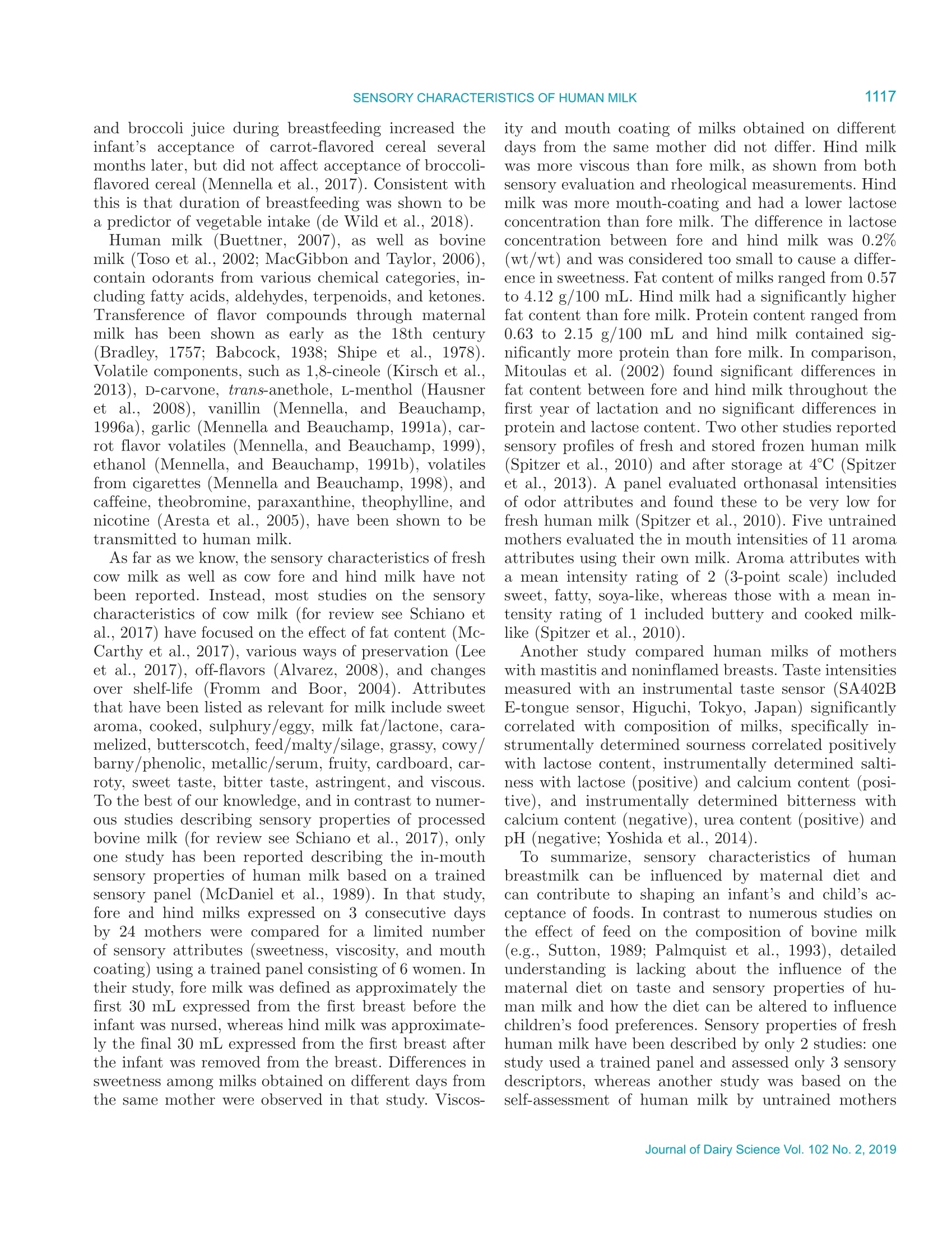
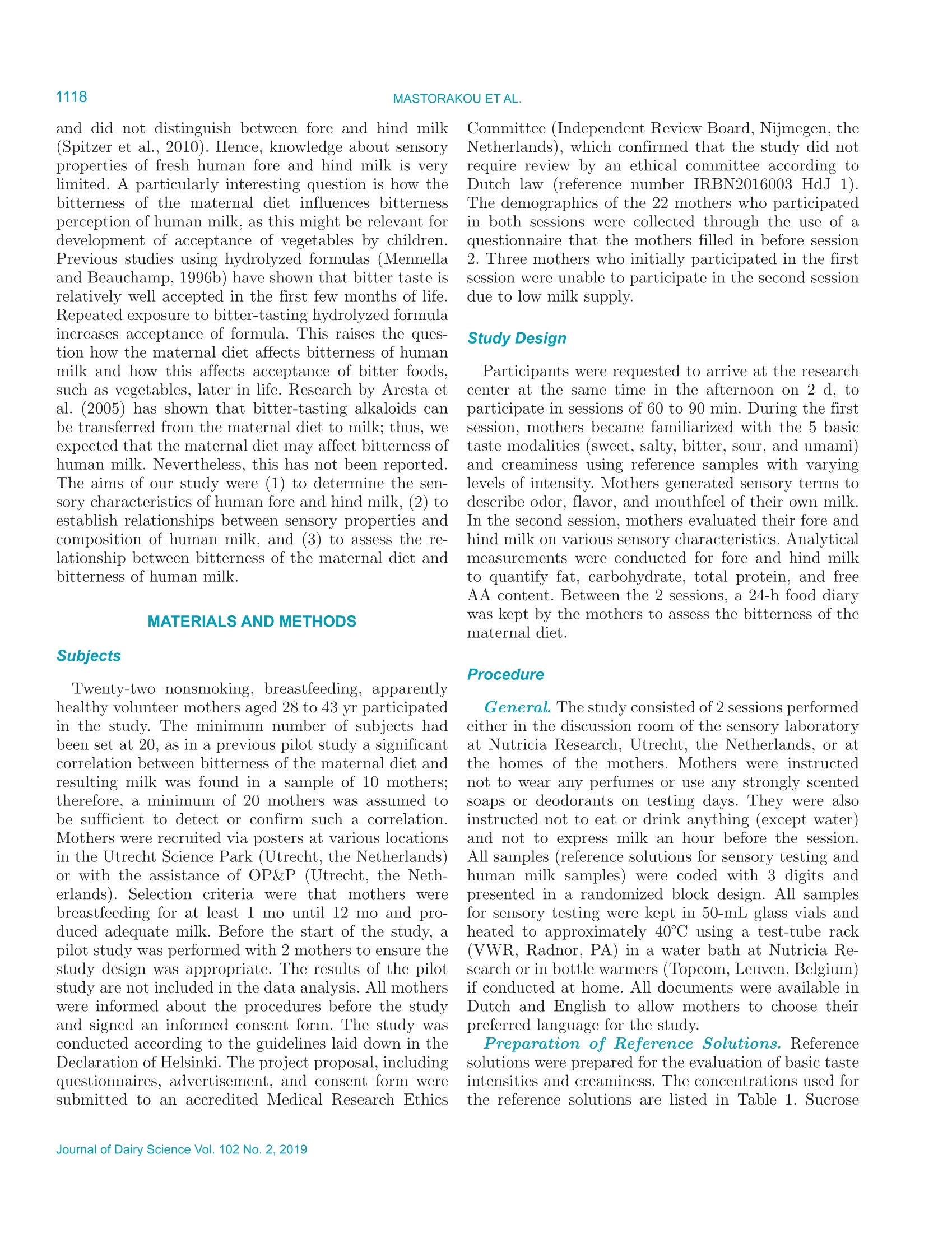
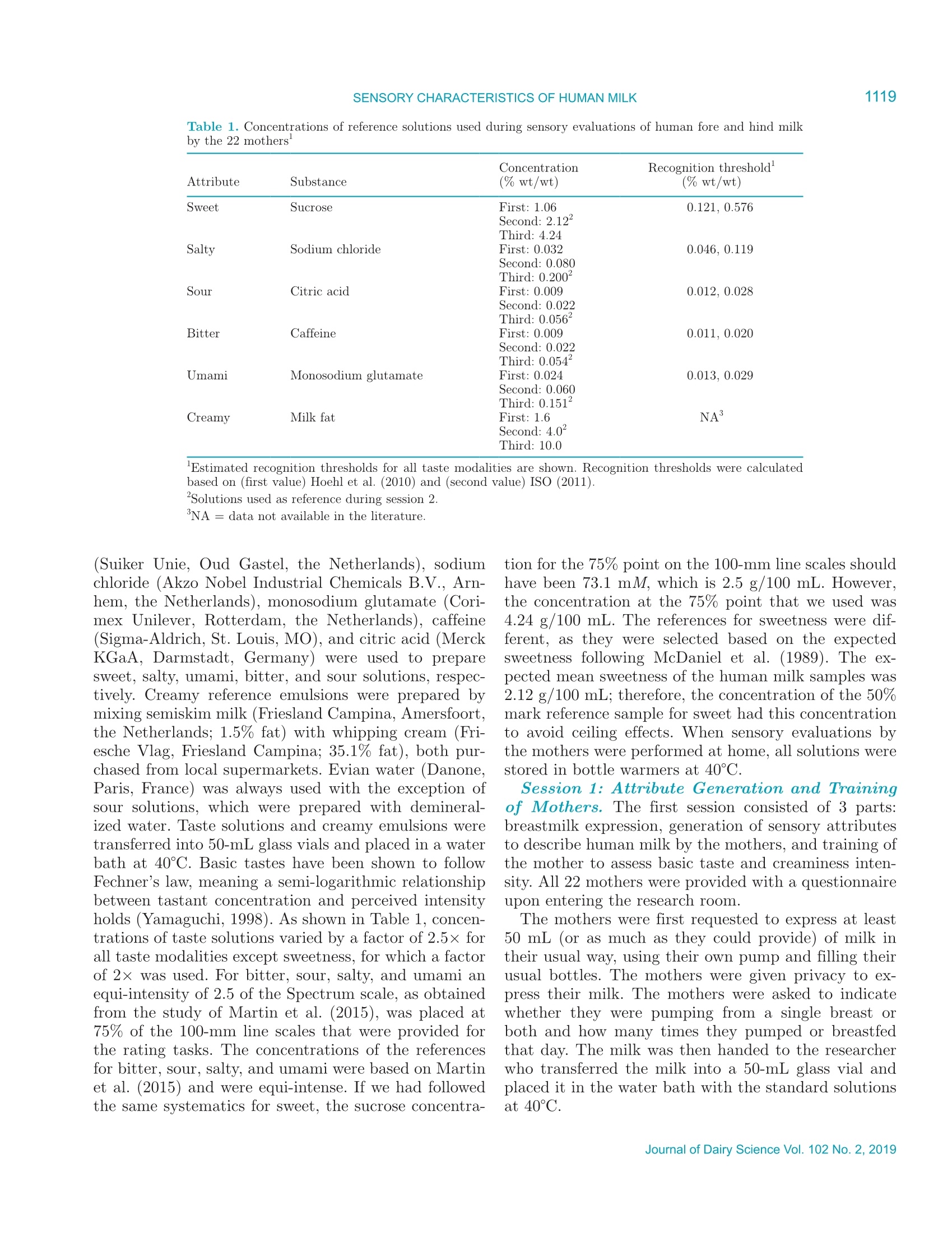
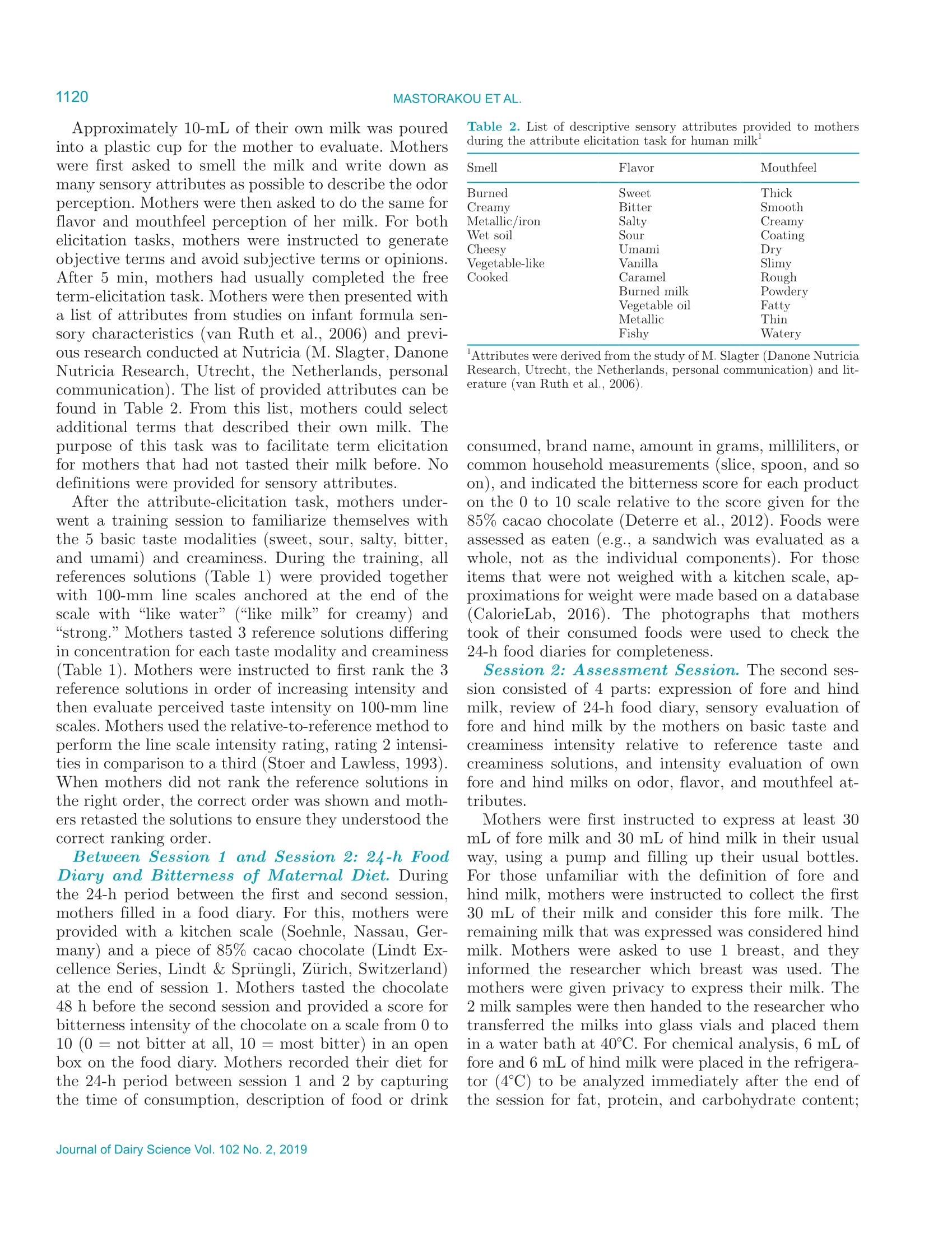
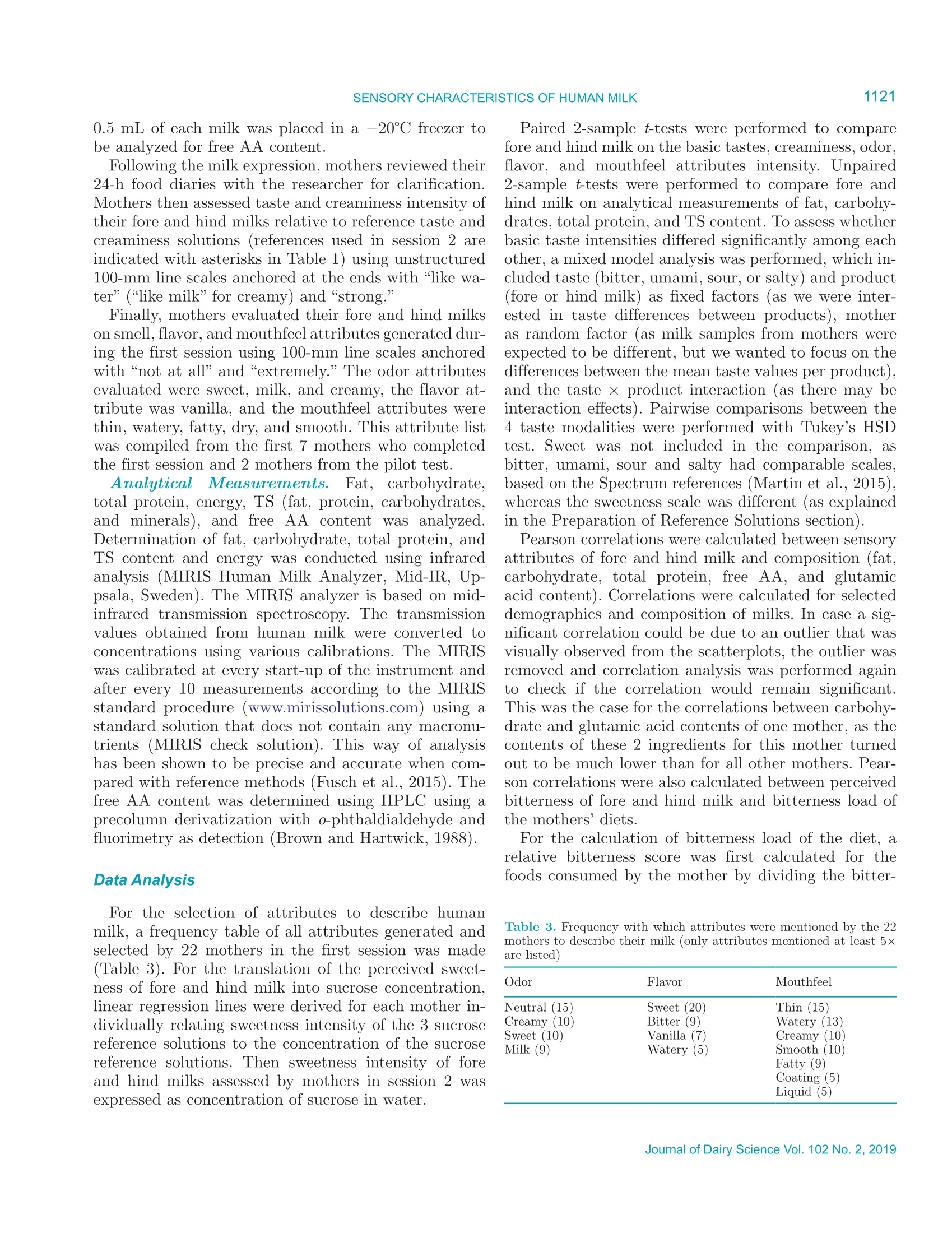

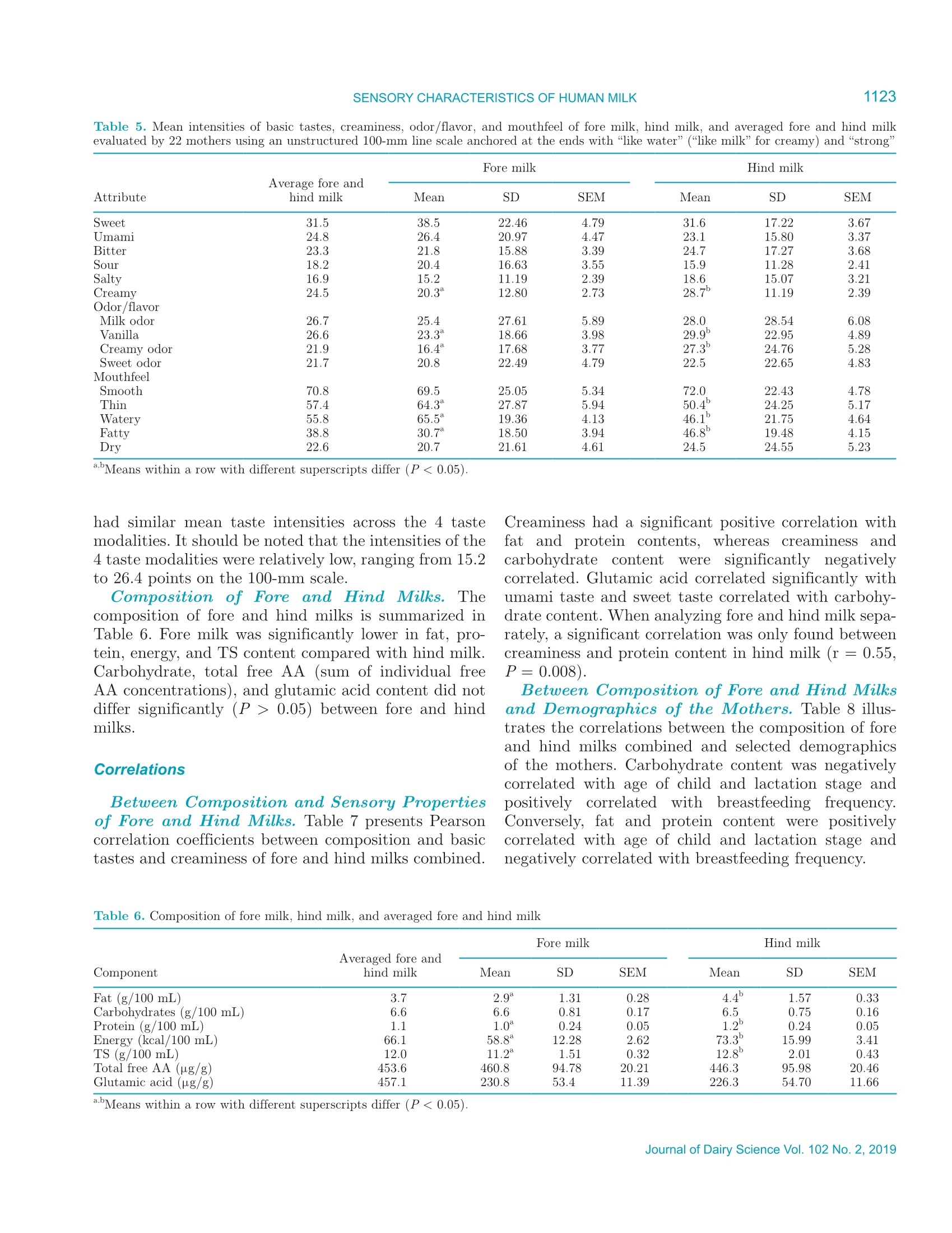


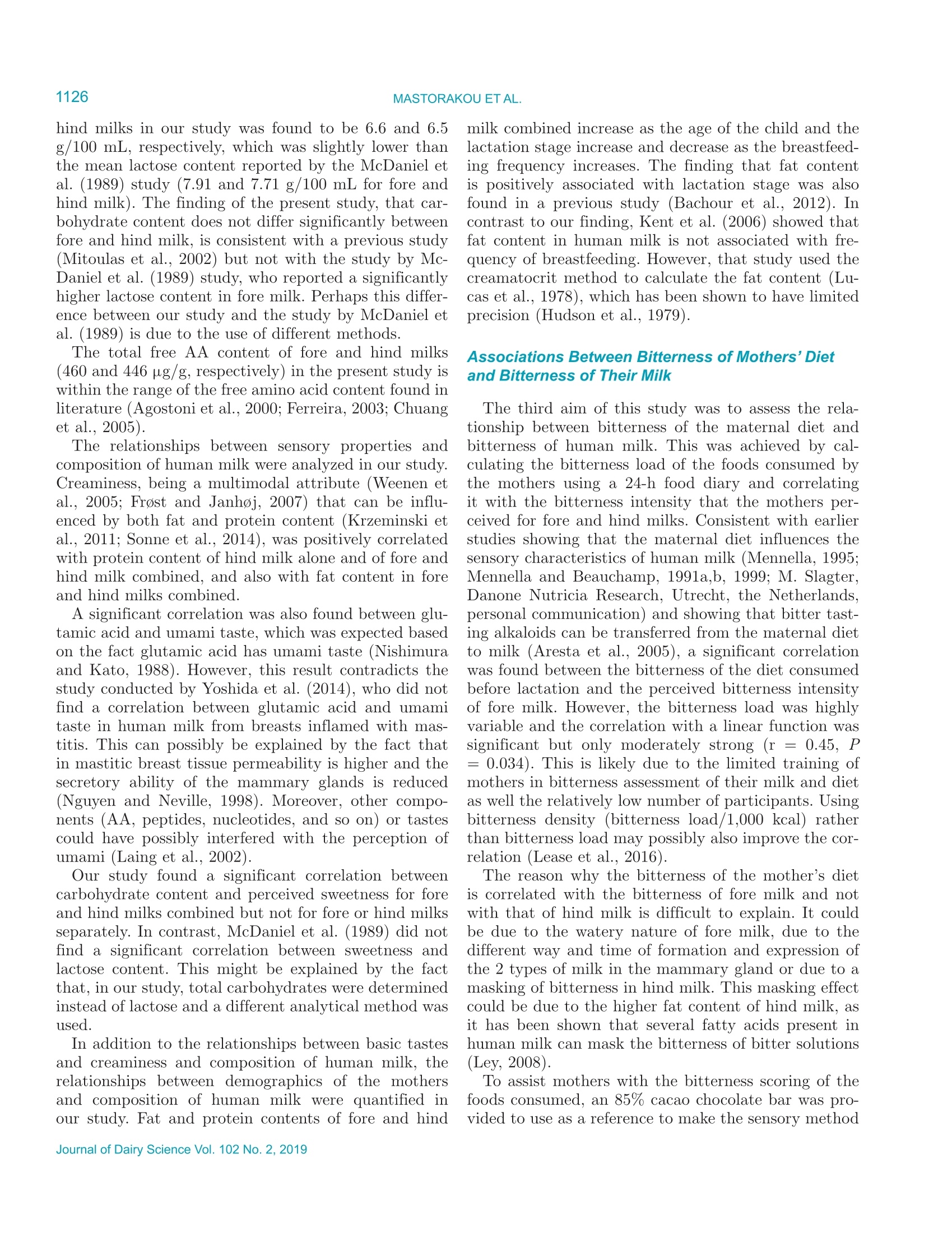
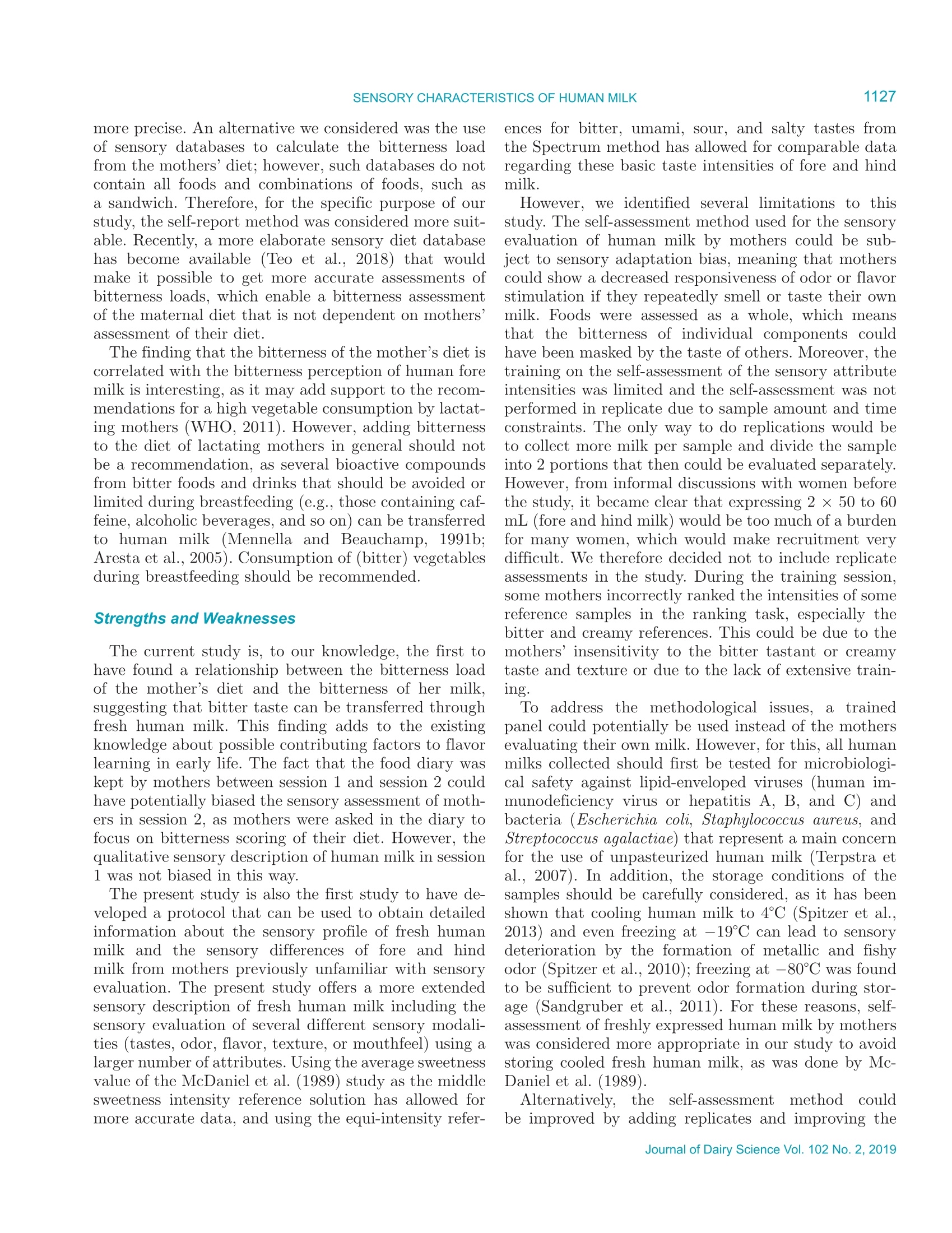
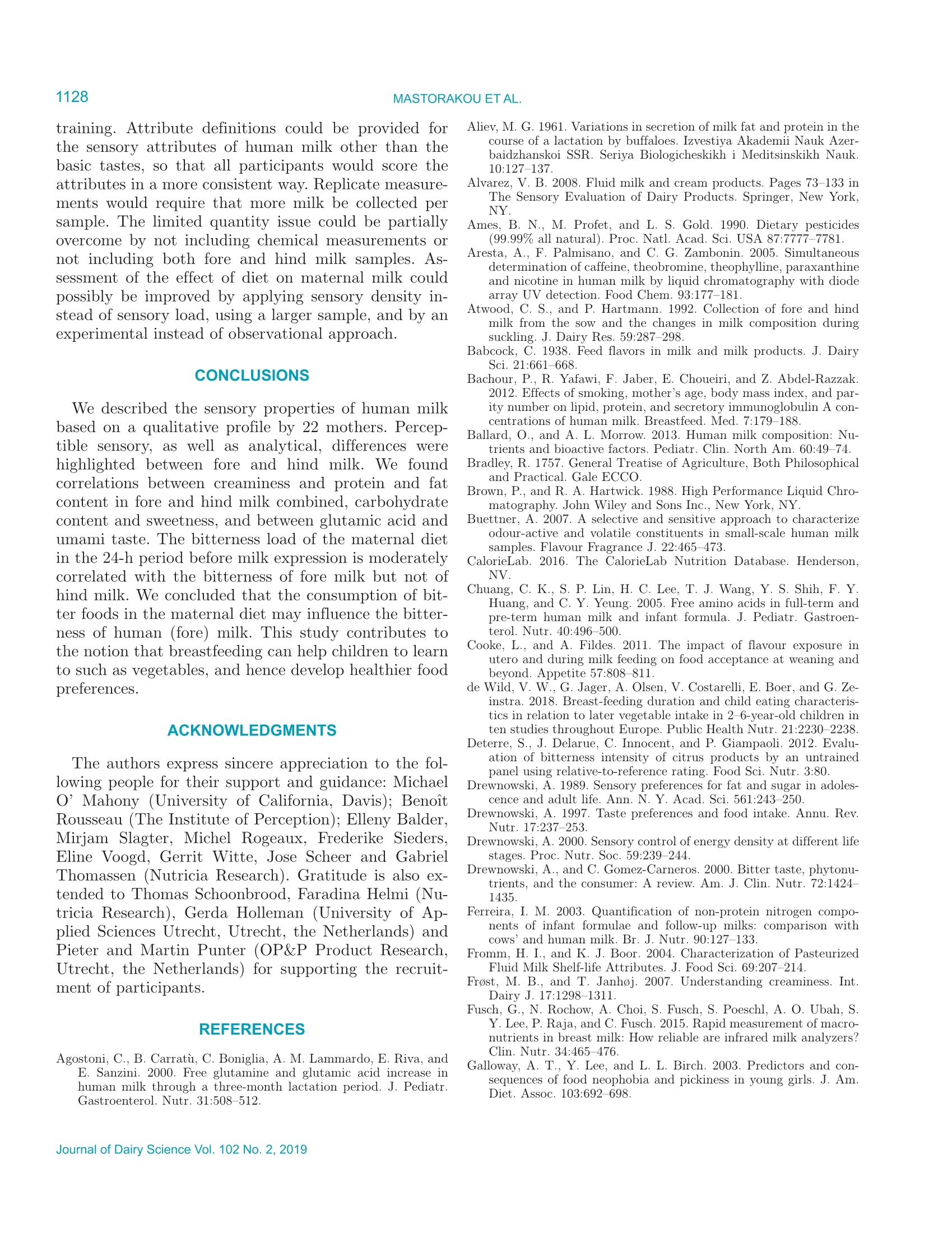
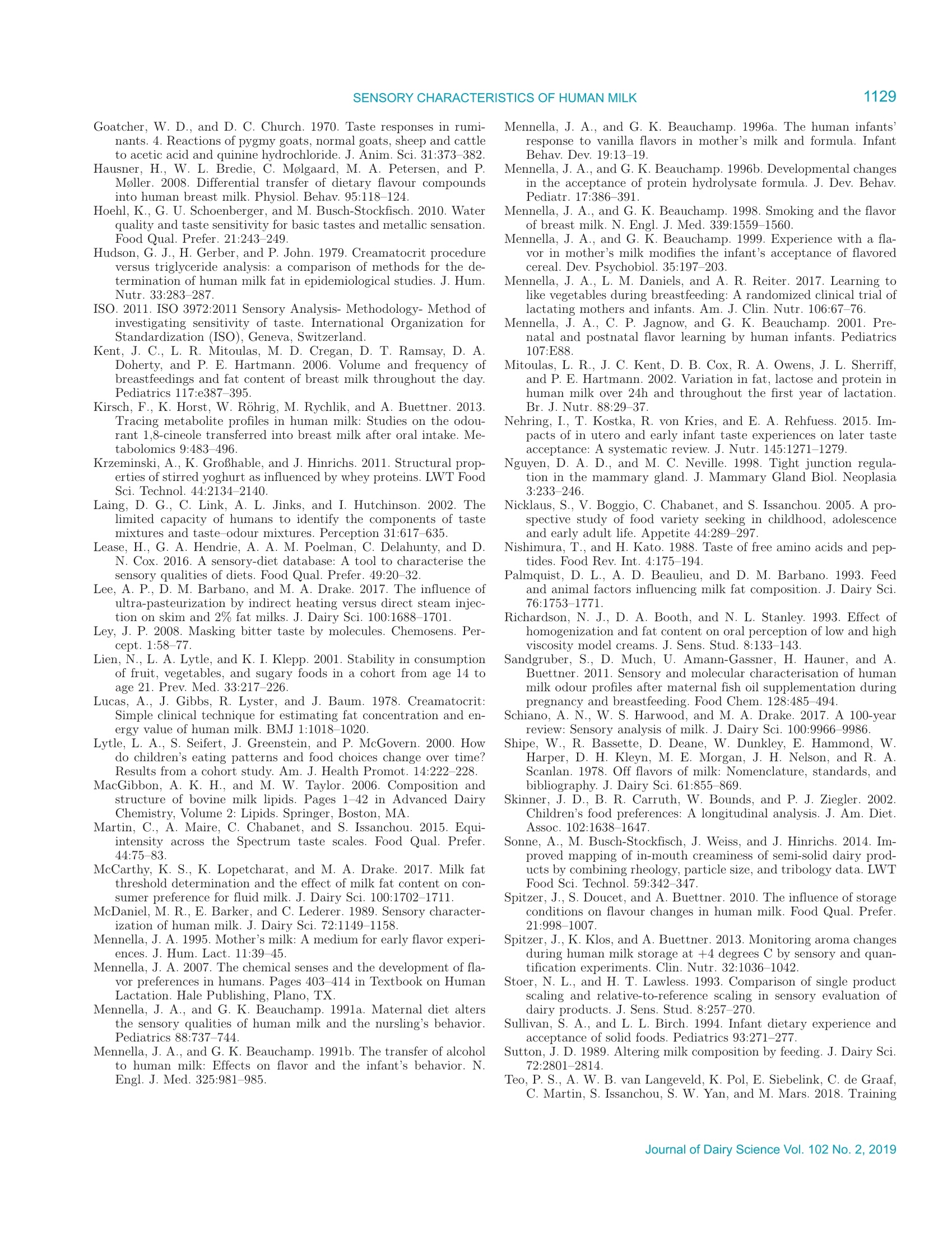


还剩14页未读,是否继续阅读?
北京盈盛恒泰科技有限责任公司为您提供《母乳中感官特征检测方案(感官智能分析)》,该方案主要用于液体乳中理化分析检测,参考标准--,《母乳中感官特征检测方案(感官智能分析)》用到的仪器有日本INSENT味觉分析系统(电子舌)
推荐专场
感官智能分析系统(电子鼻/电子舌)
相关方案
更多
该厂商其他方案
更多









